The History of Space Travel Timeline
Albert II became the first monkey in space on June 14, 1949, in a specially adapted US V2 rocket.
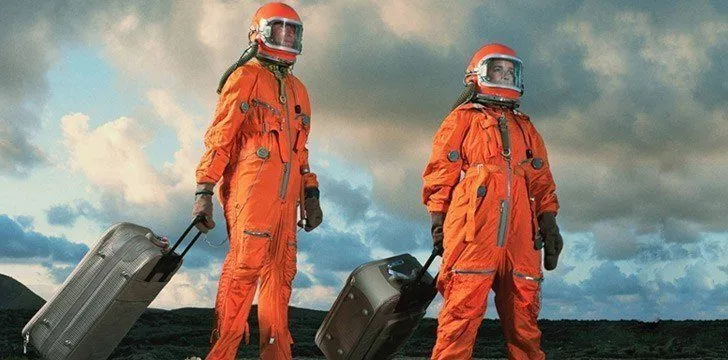
To travel into the unknown of space is a dream for so many children and adults alike, although one that very few will ever reach.
Throughout time so many countries, and now private companies, across the world have tried to create a method of getting in amongst the stars.
It’s even united countries that previously had such strong conflict.
Here we’re going to go through a timeline of the significant moments in the history of space travel, starting way back in the 1940s.
In 1942 the German V2 rocket, designed by Wernher Von Braun, was the first to reach 100km (62 miles) from the Earth’s surface.
Also known as the boundary of space.
Braun later worked with NASA on the rockets that went to the moon.
In 1947, the first animals went into space.
Fruit flies were used to study the effects of space travel on animals as they’re very similar to humans.
The flies traveled with a supply of corn to eat on the flight.
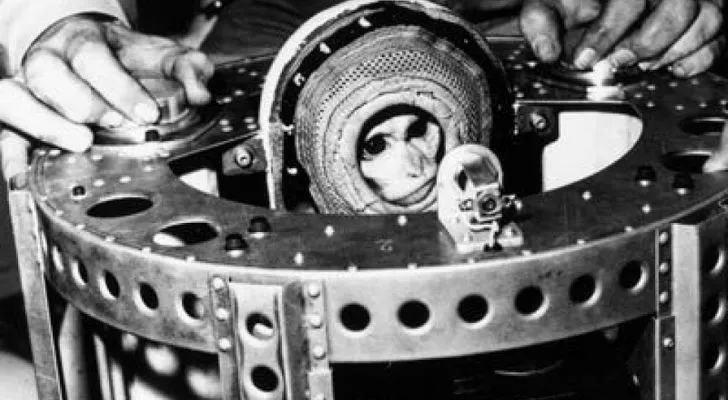
Albert II was the first monkey in space.
Albert II was a Rhesus monkey and boldly went where no primate had been before on June 14 , 1949, in a specially adapted US V2 rocket, that flew 83 miles from Earth.
On October 4 , 1957, Russia launched the first space satellite (or sputnik in Russian) named Sputnik 1.
Sputnik 1 was the first satellite in orbit around the earth.
In November the same year, Laika the Russian dog became the first animal to orbit the earth. Laika is Russian for “Barker”.
She traveled in Sputnik 2 and helped understand whether people could survive in space.
By 1959 Both US and Russian scientists were in a race to get a craft to the Moon; the Russians won.
Space-probe Luna 2 crash-landed into the moon at fatal speeds.
Ten years later, the first human visited the surface.
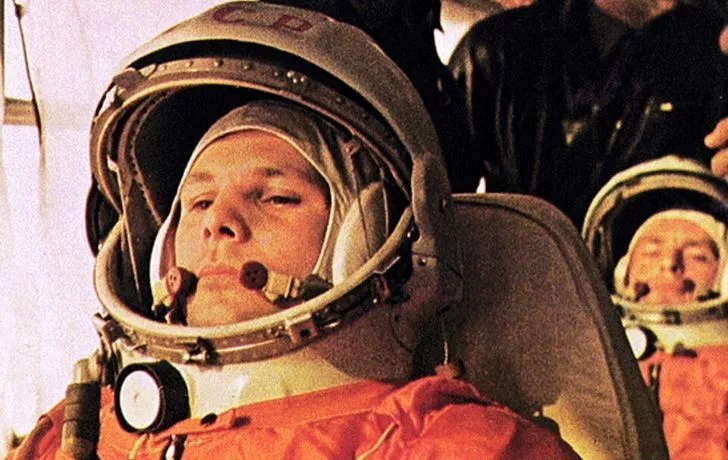
On April 12, 1961 , Russian Cosmonaut Yuri Gagarin became the first man in space.
Traveling in Vostok 1 he completed one orbit of the earth, landing about two hours after launch.
Gagarin had to eject and use a parachute to land as the craft was designed to crash land.
John Glenn became the first US man to orbit the Earth aboard the Friendship 7.
John actually chose this name; officially the craft is called the Mercury-Atlas 6, for the mission Mercury and it being the 6 th flight to use the faster Atlas rocket.
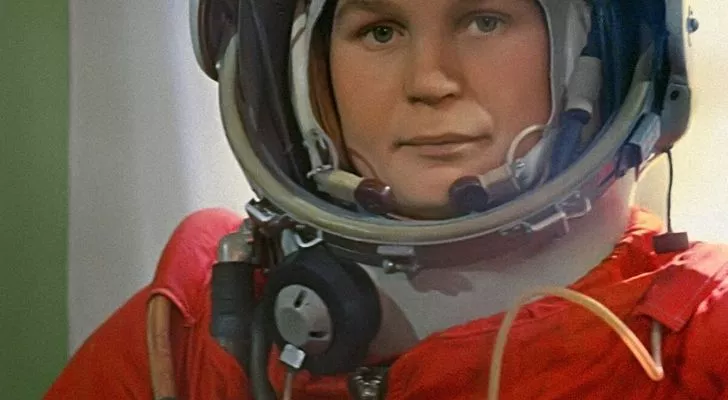
Valentina Tereshkova, a Russian cosmonaut, became the first woman in space.
After her mission, she had a crater on the far side of the Moon is named after her.
Who could believe, after just sending men to the moon, NASA managed to successfully conduct the first Mars flyby with their Mariner 4 craft.
In 1963 John F. Kennedy promised that by 1970 the US would have put men on the moon.
NASA firstly sent a robot spaceship called Surveyor 1, to make sure they could safely land.
It reached the moon on May 30 , 1966, just after the Russian probe Luna 9.
Once Surveyor 1 landed it took photographs and sent them back to eagerly awaiting scientists who used them to visualize the terrain and work out a plan to land people on the moon safely.
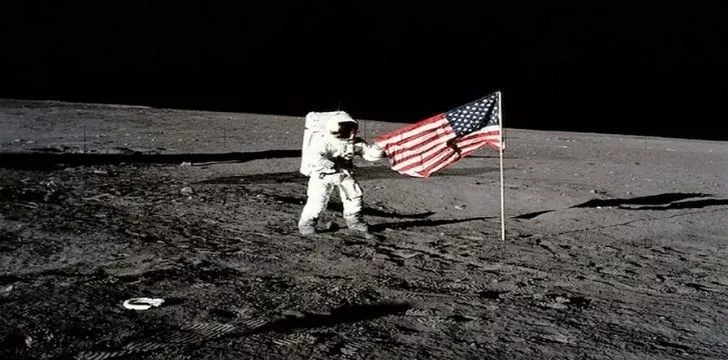
On July 20 , 1969, the famous “one small step” was taken by Neil Armstrong and Buzz Aldrin, and the first words were spoken, “the Eagle has landed”.
This iconic phrase confirmed them as the first men on the moon.
The Apollo 11 craft flew them 250,000 miles to the moon and back.
Apollo 13 on April 13, 1970 , the second day of its trip to the moon, suffered a wiring fault causing an explosion.
Using what was on board, NASA and the astronauts on board made repairs to bring the damaged craft back to Earth.
This saw the first use of the Lunar Rover, an electric vehicle with a top speed of 8 mph (13 kph), to explore the moon on the fourth, fifth and sixth Apollo missions.
The rover took Boeing 17 months to design and develop.
The first-ever space station was launched in 1971, the Russian Salyut 1, and was launched from an unmanned rocket.
In 1973 Mars 2, a 2-part Russian probe explored Mars .
One part was to stay in orbit for the whole year sending pictures back to earth and the other was to land and explore Mars’ surface.
It was destroyed when a parachute failed.
The US launched their Voyager 1 deep space probe.
Voyager 1, on February 17, 1998 , became the most distant human-made object in space after it passed the previous title holder; Pioneer 10.
From April 12, 1981, saw the idea of reusable space crafts, prior to this they were a one-hit-wonder.
The Space Shuttle was designed to lower costs and could be used up to 100 times.
With five rocket motors, it reached 17,000+ mph (27,350+ Kph). Six were built and 2011 saw their last use.
The first craft to start the Space Shuttle era was called Columbia.
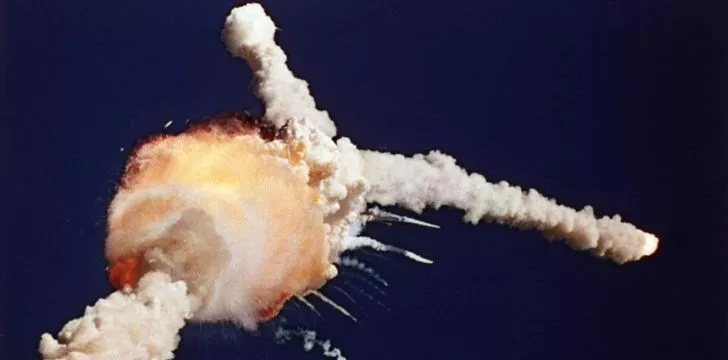
On January 28, 1986 , Space Shuttle Challenger exploded due to a fuel system failure just after launch.
All seven astronauts were killed.
After this tragedy, all shuttles were grounded for almost three years.
In the same year, Construction started on the MIR space station, the first consistently inhabited long-term space station.
It was built in sections, taking 10 years, with each bit rocket-launched and combined in orbit.
In 2001 it was destroyed on its descent to earth. The ISS or International Space station also started construction in this year designed for research and space exploration.
The final major module of the ISS didn’t arrive until 2010.
The shuttle Discovery was launched to deploy the Hubble Space Telescope into Earth’s Orbit.
The telescope is able to lock onto a target without moving to about the width of a human hair seen a mile away, or more scientifically, more than 7/1000 th of an arcsecond.
Just like there are 60 minutes in an hour, there are 60 arcminutes in 1 degree, and 60 arcseconds in an arcminute.
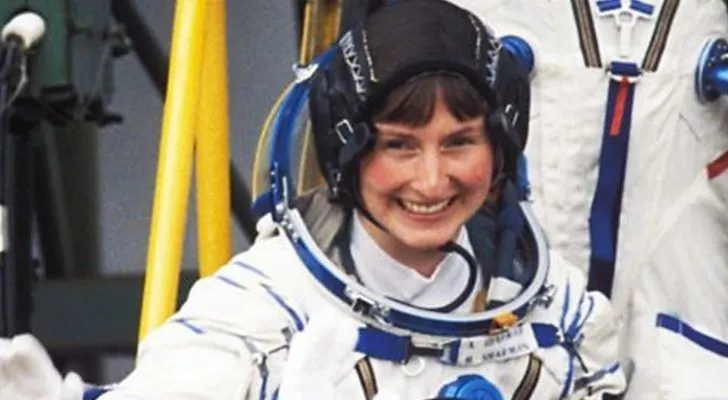
In 1989, Helen Sharman won a competition to become the first British astronaut in space, she previously worked for Mars Bar.
After 18 months of harsh training, she joined a Russian mission to the MIR space station.
After all their problems, the US and Russia finally start working together, or at least in space terms they were.
This year saw the US shuttle Atlantis dock at the Russian MIR space station.
The first look at mars occurred when Sojourner, A U.S rover, travels onto Mars to explore the planet’s geology.
In 2000 the first permanent crew inhabited the International Space Station (ISS), and have been there ever since.
On April 28, 2001 , US millionaire Dennis Tito spent around $20,000,000 and had 900 hours of training to be the first space tourist for a ride in a Russian Soyuz spacecraft.
He spent one week in orbit and of this time he spent most visiting the ISS.
This symbolized the hopes for space travel, for it to become a normal venture one day for everyone.
On June 21 , 2004, the first privately funded manned space flight happened with the craft SpaceShipOne.
An adaptation of this technology is being used by Virgin Galactic, a company offering private tourist flights into space.
Even though in 2014 it crashed during testing, flights are still happening.
In this year, the European Space Agency launched their Rosetta probe hoping to reach Comet 67P/Churyumov–Gerasimenko.
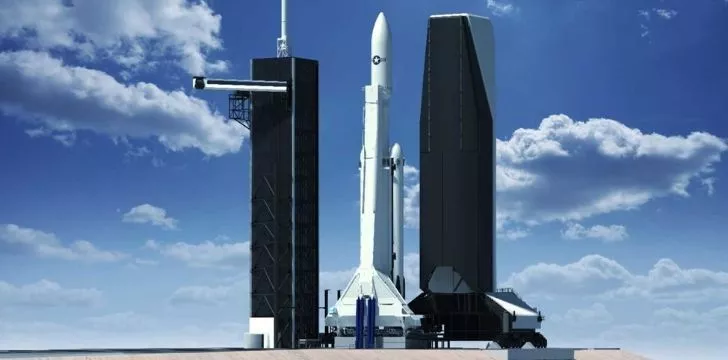
SpaceX, a private company that built a craft to replace the newly retired Space Shuttle, became the first to launch a privately funded liquid-fueled rocket into Orbit, the Falcon 1.
These rockets are used to launch their Dragon capsule, a remote-controlled capsule that takes supplies to the ISS.
The U.S Messenger mission to Mercury , launched in 2004, made its journey successfully traveling 48 million miles (77 million km), to begin its yearlong orbit of the mysterious planet.
Russia launched the largest space telescope to date named Spekt-R beating the Hubble.
The device is built to study astronomical objects with an angular resolution of a few millionths of an arcsecond.
The colossal telescope weighed 11,000 pounds (5,000 kilograms).
A major moment for commercial space travel started on May 22 nd , SpaceX launched another Dragon C2+ powered by their Falcon 9 rocket to deliver a resupplying capsule to the ISS.
The capsule was caught by the ISS’s robotic arm and docked for nearly six days while astronauts removed cargo and loaded that destined for Earth, a trip it made with no real complications.
NASA’s Curiosity rover, a piece of equipment the size of a car, landed on Mars on August 6 th .
It’s the largest and most advanced rover ever to land on the red planet.
On August 25 th , Voyager 1, launched in the late ‘70s, became the first man-made spacecraft to cross into interstellar space.
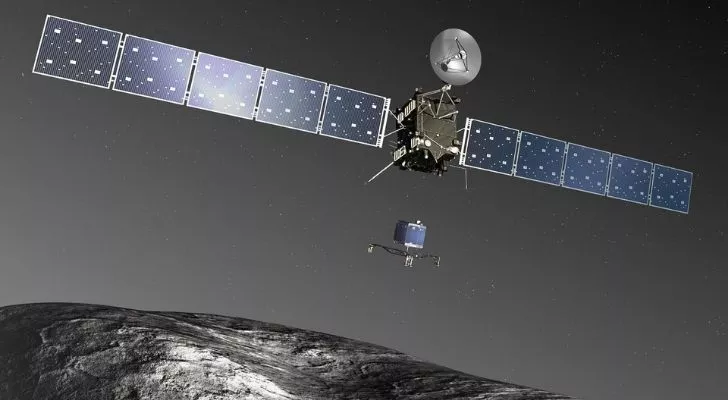
The Rosetta probe, launched in 2004, finally reached Comet 67P/Churyumov–Gerasimenko after a 4 billion-mile journey.
Whilst on the comet, the lander sent data and high-resolution images from the Comet’s surface back to earth including 490-foot cliffs and house-sized boulders.
The Philae lander made a soft landing on November 12 th after a perilous 7-hour descent.
Harpoons designed to attach to the comet failed, and the lander bounced twice before landing successfully.
On March 6 th , NASA’s Dawn spacecraft entered an orbit around a dwarf planet Ceres, the largest object in the asteroid belt between Mars and Jupiter .
With a 590 mile (950 km) diameter, it makes up a quarter of the mass of the belt.
July 14 th saw NASA’s New Horizons spacecraft arrive at Pluto after traveling 9 years and 4.6 billion miles.
It passes, during its closest approach, only 7,750 miles from the surface and took high-resolution photos of Pluto and Charon, the largest moon.
Pluto is said to be about 50 miles larger than thought.
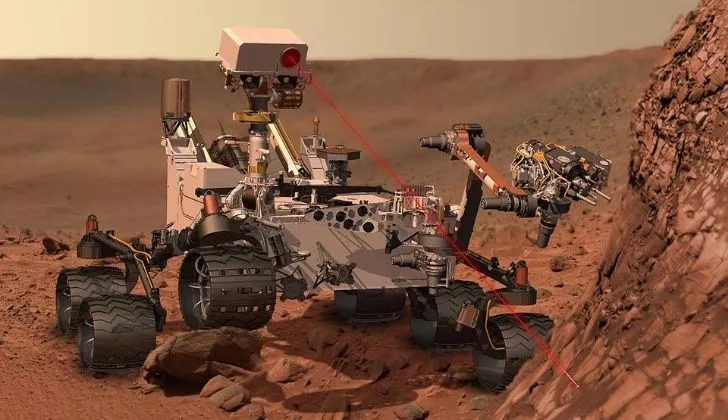
On July 30 , 2020, at 11:50 UTC, NASA launched their Mars Rover, which was the largest of four missions to Mars in 2020 .
Without a doubt, this mission plans to be the most fruitful with the craft equipped with state-of-the-art modern technology and engineering capable of truly exploring the martian land like never before!
The Mars Rover’s mission among other things is to see if the red planet has ever accommodated extra-terrestrial life by exploring any signs of habitable conditions both in the past and present.
Space travel has for so many people mesmerized them from a very young age, myself included, and as this list has shown, there is always something new to discover!
We have barely scratched the surface, and yet every year we learn or launch something new with the dream of reaching some unknown bit of the universe.
To travel to the furthest edge man can reach will always be the aim.
To unearth the secrets hidden, to find life or anything that’s interesting and bewildering drives some of the best minds in the world every day.
- Space Kids - Space History
- Hubblesite.org
- NASA - Mission Status

Related Posts

100 Interesting Space Facts That’ll Blow Your Mind
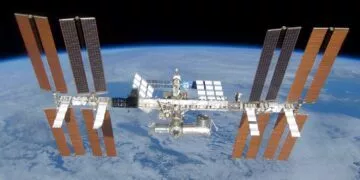
10 Incredible Facts About The International Space Station
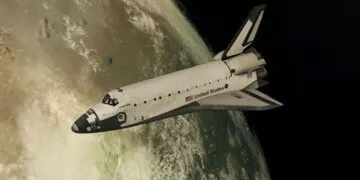
26 Facts About Space Shuttles That Are Outta This World!

Is Space Completely Silent?
About the author.

Dan Lewis has worked in the tech sector for about 7 years and is qualified in most areas including networking, hardware, software & support. Enjoys writing about anything techy, nerdy or factually interesting.
Popular Today

April 22: Facts & Historical Events On This Day

50 Fascinating Earth Day Facts For Kids
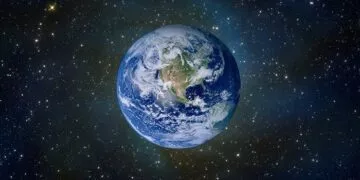
30 Incredible Facts About The Earth

20 Facts About Daisies & Sweet Peas, April’s Birth Flowers
We have a thorough fact-checking process and a dedicated team verifying our content for accuracy. But occasionally, we may get things wrong, or information becomes outdated. If you believe something to be incorrect, please leave us a message below.
Leave a Comment
Latest facts.
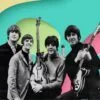
20 Facts About the Beatles That Won’t Let You Down

15 Enchanting Facts About Estonia

National Pet Day | April 11

31 Fast-Paced Facts About Pickleball

The Fact Site is the number one source for the most interesting & random facts about animals, celebrities, food, films, games & so much more. You will learn something about everything!
Popular Facts Lists
1000 Interesting Facts
100 Random Fun Facts
100 Mind Blowing Facts
100 Strange But True Facts
100 Interesting Space Facts
Popular Pages
2024 Events & Facts
Big Questions
Today In History
World Records
Information
Privacy Policy
The Fact Shop
The History of Space Exploration
During the time that has passed since the launching of the first artificial satellite in 1957, astronauts have traveled to the moon, probes have explored the solar system, and instruments in space have discovered thousands of planets around other stars.
Earth Science, Astronomy, Social Studies, U.S. History, World History
Apollo 11 Astronauts on Moon
A less belligerent, but no less competitive, part of the Cold War was the space race. The Soviet Union bested its rival at nearly every turn, until the U.S. beat them to the finish line by landing astronauts on the moon.
NASA photograph
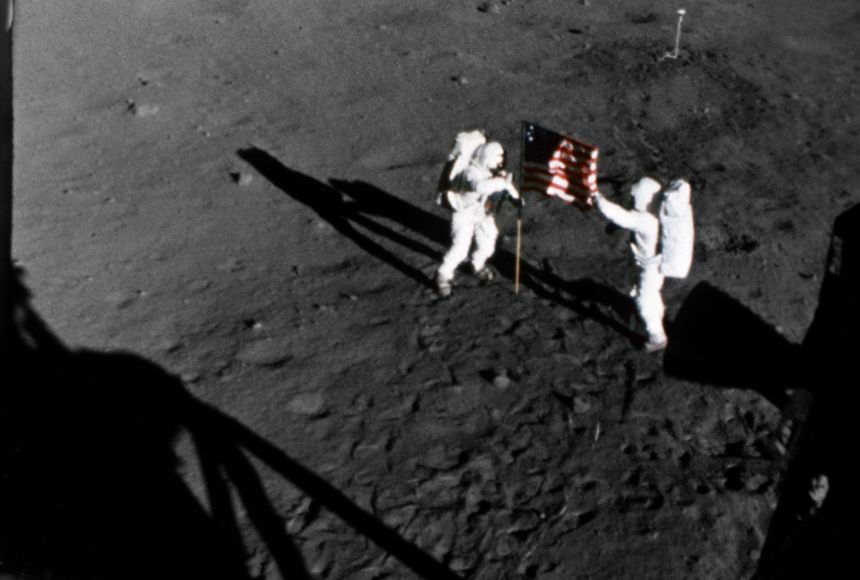
We human beings have been venturing into space since October 4, 1957, when the Union of Soviet Socialist Republics (U.S.S.R.) launched Sputnik, the first artificial satellite to orbit Earth. This happened during the period of political hostility between the Soviet Union and the United States known as the Cold War. For several years, the two superpowers had been competing to develop missiles, called intercontinental ballistic missiles (ICBMs), to carry nuclear weapons between continents. In the U.S.S.R., the rocket designer Sergei Korolev had developed the first ICBM, a rocket called the R7, which would begin the space race. This competition came to a head with the launch of Sputnik . Carried atop an R7 rocket, the Sputnik satellite was able to send out beeps from a radio transmitter. After reaching space, Sputnik orbited Earth once every 96 minutes. The radio beeps could be detected on the ground as the satellite passed overhead, so people all around the world knew that it was really in orbit. Realizing that the U.S.S.R. had capabilities that exceeded U.S. technologies that could endanger Americans, the United States grew worried. Then, a month later, on November 3, 1957, the Soviets achieved an even more impressive space venture. This was Sputnik II, a satellite that carried a living creature, a dog named Laika. Prior to the launch of Sputnik, the United States had been working on its own capability to launch a satellite. The United States made two failed attempts to launch a satellite into space before succeeding with a rocket that carried a satellite called Explorer on January 31, 1958. The team that achieved this first U.S. satellite launch consisted largely of German rocket engineers who had once developed ballistic missiles for Nazi Germany. Working for the U.S. Army at the Redstone Arsenal in Huntsville, Alabama, the German rocket engineers were led by Wernher von Braun and had developed the German V2 rocket into a more powerful rocket, called the Jupiter C, or Juno. Explorer carried several instruments into space for conducting science experiments. One instrument was a Geiger counter for detecting cosmic rays. This was for an experiment operated by researcher James Van Allen, which, together with measurements from later satellites, proved the existence of what are now called the Van Allen radiation belts around Earth. In 1958, space exploration activities in the United States were consolidated into a new government agency, the National Aeronautics and Space Administration (NASA). When it began operations in October of 1958, NASA absorbed what had been called the National Advisory Committee for Aeronautics (NACA), and several other research and military facilities, including the Army Ballistic Missile Agency (the Redstone Arsenal) in Huntsville. The first human in space was the Soviet cosmonaut Yuri Gagarin, who made one orbit around Earth on April 12, 1961, on a flight that lasted 108 minutes. A little more than three weeks later, NASA launched astronaut Alan Shepard into space, not on an orbital flight, but on a suborbital trajectory—a flight that goes into space but does not go all the way around Earth. Shepard’s suborbital flight lasted just over 15 minutes. Three weeks later, on May 25, President John F. Kennedy challenged the United States to an ambitious goal, declaring: “I believe that this nation should commit itself to achieving the goal, before the decade is out, of landing a man on the moon and returning him safely to Earth." In addition to launching the first artificial satellite, the first dog in space, and the first human in space, the Soviet Union achieved other space milestones ahead of the United States. These milestones included Luna 2, which became the first human-made object to hit the Moon in 1959. Soon after that, the U.S.S.R. launched Luna 3 . Less than four months after Gagarin’s flight in 1961, a second Soviet human mission orbited a cosmonaut around Earth for a full day. The U.S.S.R. also achieved the first spacewalk and launched the Vostok 6 mission, which made Valentina Tereshkova the first woman to travel to space. During the 1960s, NASA made progress toward President Kennedy’s goal of landing a human on the moon with a program called Project Gemini, in which astronauts tested technology needed for future flights to the moon, and tested their own ability to endure many days in spaceflight. Project Gemini was followed by Project Apollo, which took astronauts into orbit around the moon and to the lunar surface between 1968 and 1972. In 1969, on Apollo11, the United States sent the first astronauts to the Moon, and Neil Armstrong became the first human to set foot on its surface. During the landed missions, astronauts collected samples of rocks and lunar dust that scientists still study to learn about the moon. During the 1960s and 1970s, NASA also launched a series of space probes called Mariner, which studied Venus, Mars, and Mercury. Space stations marked the next phase of space exploration. The first space station in Earth orbit was the Soviet Salyut 1 station, which was launched in 1971. This was followed by NASA’s Skylab space station, the first orbital laboratory in which astronauts and scientists studied Earth and the effects of spaceflight on the human body. During the 1970s, NASA also carried out Project Viking in which two probes landed on Mars, took numerous photographs, examined the chemistry of the Martian surface environment, and tested the Martian dirt (called regolith ) for the presence of microorganisms . Since the Apollo lunar program ended in 1972, human space exploration has been limited to low-Earth orbit, where many countries participate and conduct research on the International Space Station. However, unpiloted probes have traveled throughout our solar system. In recent years, probes have made a range of discoveries, including that a moon of Jupiter, called Europa, and a moon of Saturn, called Enceladus, have oceans under their surface ice that scientists think may harbor life. Meanwhile, instruments in space, such as the Kepler Space Telescope , and instruments on the ground have discovered thousands of exoplanets , planets orbiting other stars. This era of exoplanet discovery began in 1995, and advanced technology now allows instruments in space to characterize the atmospheres of some of these exoplanets.
Articles & Profiles
Media credits.
The audio, illustrations, photos, and videos are credited beneath the media asset, except for promotional images, which generally link to another page that contains the media credit. The Rights Holder for media is the person or group credited.
Production Managers
Program specialists, last updated.
April 17, 2024
User Permissions
For information on user permissions, please read our Terms of Service. If you have questions about how to cite anything on our website in your project or classroom presentation, please contact your teacher. They will best know the preferred format. When you reach out to them, you will need the page title, URL, and the date you accessed the resource.
If a media asset is downloadable, a download button appears in the corner of the media viewer. If no button appears, you cannot download or save the media.
Text on this page is printable and can be used according to our Terms of Service .
Interactives
Any interactives on this page can only be played while you are visiting our website. You cannot download interactives.
Related Resources
Timeline: 50 Years of Spaceflight
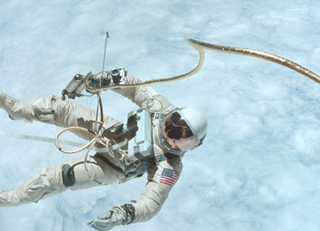
On Oct. 4, 2007, the Space Age celebrated the 50th anniversary of the historic launch of Sputnik, the first artificial satellite, by the former Soviet Union.
The space shot also launched the Space Race to the moon between the United States and the Soviet Union. But despite that turbulent beginning, the initial launch has led to five decades of triumphs and tragedies in space science and exploration .
Below is a timeline by Space News and SPACE.com chronicling the first 50 years of spaceflight. You are invited to walk through the half century of space exploration and click related links for more in depth information:
Sometime in the 11th century: China combines sulfur, charcoal and saltpeter (potassium nitrate) to make gunpowder, the first fuel used to propel early rockets in Chinese warfare.
July 4, 1054: Chinese astronomers observe the supernova in Taurus that formed the Crab Nebula .
Mid-1700s: Hyder Ali, the Sultan of Mysome in India, begins manufacturing rockets sheathed in iron, not cardboard or paper, to improve their range and stability.
March 16, 1926: Robert Goddard, sometimes referred to as the "Father of Modern Rocketry," launches the first successful liquid-fueled rocket.
July 17, 1929: Robert Goddard launches a rocket that carries with it the first set of scientific tools — a barometer and a camera — in Auburn, Mass. The launch was Goddard's fourth.
Feb. 18, 1930: The dwarf planet Pluto is discovered by American astronomer Clyde Tombaugh at Lowell Observatory in Flagstaff, Ariz.
Oct. 3, 1942: Germany successfully test launches the first ballistic missile, the A4, more commonly known as the V-2, and later uses it near the end of European combat in World War II.
Sep. 29, 1945: Wernher von Braun arrives at Ft. Bliss, Texas, with six other German rocket specialists.
Oct. 14, 1947: American test pilot Chuck Yeager breaks the sound barrier for the first time in the X-1, also known as Glamorous Glennis.
Oct. 4, 1957: A modified R-7 two-stage ICBM launches the satellite Sputnik 1 from Tyuratam. The Space Race between the Soviet Union and the United States begins.
Nov. 3, 1957: The Soviet Union launches Sputnik 2 with the first living passenger, the dog Laika , aboard.
Dec. 6, 1957: A Vanguard TV-3 carrying a grapefruit-sized satellite explodes at launch; a failed response to the Sputnik launch by the United States.
Jan. 31, 1958: Explorer 1, the first satellite with an onboard telemetry system, is launched by the United States into orbit aboard a Juno rocket and returns data from space.
Oct. 7, 1958: NASA Administrator T. Keith Glennan publicly announces NASA's manned spaceflight program along with the formation of the Space Task Group, a panel of scientist and engineers from space-policy organizations absorbed by NASA. The announcement came just six days after NASA was founded.
Jan. 2, 1959: The U.S.S.R. launches Luna 1, which misses the moon but becomes the first artificial object to leave Earth orbit.
Jan. 12, 1959: NASA awards McDonnell Corp. the contract to manufacture the Mercury capsules.
Feb. 28, 1959: NASA launches Discover 1, the U.S. first spy satellite, but it is not until the Aug. 11, 1960, launch of Discover 13 that film is recovered successfully.
May 28, 1959: The United States launches the first primates in space, Able and Baker, on a suborbital flight.
Aug. 7, 1959: NASA's Explorer 6 launches and provides the first photographs of the Earth from space.
Sept. 12, 1959: The Soviet Union's Luna 2 is launched and two days later is intentionally crashed into the Moon.
Sept. 17, 1959: NASA's X-15 hypersonic research plane , capable of speeds to Mach 6.7, makes its first powered flight.
Oct. 24, 1960: To rush the launch of a Mars probe before the Nov. 7 anniversary of the Bolshevik Revolution, Field Marshall Mitrofan Nedelin ignored several safety protocols and 126 people are killed when the R-16 ICBM explodes at the Baikonur Cosmodrome during launch preparations.
Feb. 12, 1961: The Soviet Union launches Venera to Venus, but the probe stops responding after a week.
April 12, 1961: Yuri Gagarin becomes the first man in space with a 108-minute flight on Vostok 1 in which he completed one orbit.
May 5, 1961: Mercury Freedom 7 launches on a Redstone rocket for a 15-minute suborbital flight, making Alan Shepard the first American in space.
May 25, 1961: In a speech before Congress, President John Kennedy announces that an American will land on the moon and be returned safely to Earth before the end of the decade.
Oct. 27, 1961: Saturn 1, the rocket for the initial Apollo missions, is tested for the first time.
Feb. 20, 1962: John Glenn makes the first U.S. manned orbital flight aboard Mercury 6.
June 7, 1962: Wernher von Braun backs the idea of a Lunar Orbit Rendezvous mission.
July 10, 1962: The United States launches Telstar 1 , which enables the trans-Atlantic transmission of television signals.
June 14, 1962: Agreements are signed establishing the European Space Research Organisation and the European Launcher Development Organisation. Both eventually were dissolved.
July 28, 1962: The U.S.S.R launches its first successful spy satellite, designated Cosmos 7.
Aug. 27, 1962: Mariner 2 launches and eventually performs the first successful interplanetary flyby when it passes by Venus.
Sept. 29, 1962: Canada's Alouette 1 launches aboard a NASA Thor-Agena B rocket, becoming the first satellite from a country other than the United States or Soviet Union.
June 16, 1963: Valentina Tereshkova becomes the first woman to fly into space.
July 28, 1964: Ranger 7 launches and is the Ranger series' first success, taking photographs of the moon until it crashes into its surface four days later.
April 8, 1964: Gemini 1, a two-seat spacecraft system, launches in an unmanned flight.
Aug. 19, 1964: NASA's Syncom 3 launches aboard a Thor-Delta rocket, becoming the first geostationary telecommunications satellite.
Oct. 12, 1964: The Soviet Union launches Voskhod 1, a modified Vostok orbiter with a three-person crew.
March 18, 1965: Soviet cosmonaut Alexei Leonov makes the first spacewalk from the Voskhod 2 orbiter.
March 23, 1965: Gemini 3, the first of the manned Gemini missions, launches with a two-person crew on a Titan 2 rocket, making astronaut Gus Grissom the first man to travel in space twice.
June 3, 1965: Ed White, during the Gemini 4 mission, becomes the first American to walk in space.
July 14, 1965: Mariner 4 executes the first successful Mars flyby.
Aug. 21, 1965: Gemini 5 launches on an eight-day mission.
Dec. 15, 1965: Gemini 6 launches and performs a rendezvous with Gemini 7.
Jan. 14, 1966: The Soviet Union's chief designer, Sergei Korolev, dies from complications stemming from routine surgery, leaving the Soviet space program without its most influential leader of the preceding 20 years.
Feb. 3, 1966: The unmanned Soviet spacecraft Luna 9 makes the first soft landing on the Moon.
March 1, 1966: The Soviet Union's Venera 3 probe becomes the first spacecraft to land on the planetVenus, but its communications system failed before data could be returned.
March 16, 1966: Gemini 8 launches on a Titan 2 rocket and later docks with a previously launched Agena rocket — the first docking between two orbiting spacecraft.
April 3, 1966: The Soviet Luna 10 space probe enters lunar orbit, becoming the first spacecraft to orbit the Moon.
June 2, 1966: Surveyor 1, a lunar lander, performs the first successful U.S. soft landing on the Moon.
Jan. 27, 1967: All three astronauts for NASA's Apollo 1 mission suffocate from smoke inhalationin a cabin fire during a launch pad test.
April 5, 1967: A review board delivers a damning report to NASA Administrator James Webb about problem areas in the Apollo spacecraft. The recommended modifications are completed by Oct. 9, 1968.
April 23, 1967: Soyuz 1 launches but myriad problems surface. The solar panels do not unfold, there are stability problems and the parachute fails to open on descent causing the death of Soviet cosmonaut Vladimir Komarov.
Oct. 11, 1968: Apollo 7 , the first manned Apollo mission, launches on a Saturn 1 for an 11-day mission in Earth orbit. The mission also featured the first live TV broadcast of humans in space.
Dec. 21, 1968: Apollo 8 launches on a Saturn V and becomes the first manned mission to orbit the moon.
Jan. 16, 1969: Soyuz 4 and Soyuz 5 rendezvous and dock and perform the first in-orbit crew transfer.
March 3, 1969: Apollo 9 launches. During the mission, tests of the lunar module are conducted in Earth orbit.
May 22, 1969: Apollo 10 's Lunar Module Snoopy comes within 8.6 miles (14 kilometers ) of the moon's surface.
July 20, 1969: Six years after U.S. President John F. Kennedy's assassination, the Apollo 11 crew lands on the Moon , fulfilling his promise to put an American there by the end of the decade and return him safely to Earth.
Nov. 26, 1965: France launches its first satellite, Astérix, on a Diamant A rocket, becoming the third nation to do so.
Feb. 11, 1970: Japan's Lambda 4 rocket launches a Japanese test satellite, Ohsumi into orbit.
April 13, 1970: An explosion ruptures thecommand module of Apollo 13 , days after launch and within reach of the moon. Abandoning the mission to save their lives, the astronauts climb into the Lunar Module and slingshot around the Moon to speed their return back to Earth.
April 24, 1970: The People's Republic of China launches its first satellite, Dong Fang Hong-1, on a Long March 1 rocket, becoming the fifth nation capable of launching its own satellites into space.
Sept. 12: 1970: The Soviet Union launches Luna 16, the first successful automated lunar sample retrieval mission.
April 19, 1971: A Proton rocket launches thefirst space station, Salyut 1 , from Baikonur.
June 6, 1971: Soyuz 11 launches successfully, docking with Salyut 1. The three cosmonauts are killed during re-entry from a pressure leak in the cabin.
July 26, 1971: Apollo 15 launches with a Boeing-built Lunar Roving Vehicle and better life-support equipment to explore the Moon.
Oct. 28, 1971: The United Kingdom successfully launches its Prospero satellite into orbit on a Black Arrow rocket, becoming the sixth nation capable of launching its own satellites into space.
Nov. 13, 1971: Mariner 9 becomes the first spacecraft to orbit Mars and provides the first complete map of the planet's surface.
Jan. 5, 1972: U.S. President Richard Nixon announces that NASA is developing a reusable launch vehicle, the space shuttle .
March 3, 1972: Pioneer 10 , the first spacecraft to leave the solar system, launches from Cape Kennedy, Fla.
Dec. 19, 1972: Apollo 17 , the last mission to the moon, returns to Earth.
May 14, 1973: A Saturn V rocket launches Skylab, the United States' first space station.
March 29, 1974: Mariner 10 becomes the first spacecraft to fly by Mercury.
April 19, 1975: The Soviet Union launches India's first satellite, Aryabhata.
May 31, 1975: The European Space Agency is formed.
July 17 1975: Soyuz-19 and Apollo 18 dock.
Aug. 9, 1975: ESA launches its first satellite, Cos-B, aboard a Thor-Delta rocket.
Sept. 9, 1975: Viking 2, composed of a lander and an orbiter, launches for Mars.
July 20, 1976: The U.S. Viking 1 lands on Mars, becoming the first successful Mars lander.
Aug. 20, 1977: Voyager 2 is launched on a course toward Uranus and Neptune.
Sept. 5, 1977: Voyager 1 is launched to perform flybys of Jupiter and Saturn.
Sept. 29, 1977: Salyut 6 reaches orbit. It is the first space station equipped with docking stations on either end, which allow for two vehicles to dock at once, including the Progress supply ship.
Feb. 22, 1978: The first GPS satellite, Navstar 1, launches aboard an Atlas F rocket.
July 11, 1979: Skylab, the first American space station, crashes back to Earth in the sparsely populated grasslands of western Australia.
Sept. 1, 1979: Pioneer 11 becomes the first spacecraft to fly past Saturn.
Dec. 24, 1979: The French-built Ariane rocket, Europe's first launch vehicle, launches successfully.
July 18 1980: India launches its Rohini 1 satellite. By using its domestically developed SLV-3 rocket, India becomes the seventh nation capable of sending objects into space by itself.
April 12, 1981: Space Shuttle Columbia lifts off from Cape Canaveral, beginning the first space mission for NASA's new astronaut transportation system.
June 24, 1982: French air force test pilot Jean-Loup Chrétien launches to the Soviet Union's Salyut 7 aboard Soyuz T-6.
Nov. 11, 1982: Shuttle Columbia launches. During its mission, it deploys two commercial communications satellites.
June 18, 1983: Sally Ride aboard the Space Shuttle Challenger becomes the first American woman in space.
Feb. 7, 1984: Astronauts Bruce McCandless and Robert Stewart maneuver as many as 328 feet (100 meters ) from the Space Shuttle Challenger using the Manned Maneuvering Unit, which contains small thrusters, in the first ever untethered spacewalks.
April 8, 1984: Challenger crew repairs the Solar Max satellite during a spacewalk.
Sept. 11: 1985: The International Cometary Explorer, launched by NASA in 1978, performs the first comet flyby.
Jan. 24, 1986: Voyager 2 completes the first and only spacecraft flyby of Uranus.
Jan. 28, 1986: Challenger broke apart 73 seconds after launch after its external tank exploded, grounding the shuttle fleet for more than two years.
Feb. 20, 1986: The Soviet Union launches theMir space station.
March 13, 1986: A two-cosmonaut crew launches aboard Soyuz T-15 to power up the Mir space station. During their 18-month mission, they also revive the abandoned Salyut 7, and take parts that are later placed aboard Mir.
June 15, 1988: PanAmSat launches its first satellite, PanAmSat 1, on an Ariane 4 rocket, giving Intelsat its first taste of competition.
Sept. 19, 1988: Israel launches its first satellite, the Ofeq 1 reconnaissance probe, aboard an Israeli Shavit rocket.
Nov. 15, 1988: The Soviet Union launches its Buran space shuttle on its only flight, an unpiloted test.
May 4, 1989: The Space Shuttle Atlantis launches the Magellan space probe to use radar to map the surface of Venus.
Oct. 18, 1989: Shuttle Atlantis launches with Jupiter-bound Galileo space probe on board.
April 7, 1990: China launches the Asiasat-1 communications satellite, completing its first commercial contract.
April 25, 1990: The Space Shuttle Discovery releases the Hubble Space Telescope into Earth orbit.
Oct. 29, 1991: The U.S. Galileo spacecraft, on its way to Jupiter, successfully encounters the asteroid Gaspra, obtaining images and other data during its flyby.
April 23, 1992: The U.S. Cosmic Background Explorer spacecraft detects the first evidence of structure in the residual radiation left over from the Big Bang that created the Universe.
Dec. 28, 1992: Lockheed and Khrunichev Enterprise announce plans to form Lockheed-Khrunichev-Energia International, a new company to market Proton rockets .
June 21, 1993: Shuttle Endeavour launches carrying Spacehab, a privately owned laboratory that sits in the shuttle cargo bay.
Dec. 2, 1993: Endeavour launches on a mission to repair the Hubble Space Telescope .
Dec. 17, 1993: DirecTV launches its first satellite, DirecTV 1, aboard an Ariane 4 rocket.
Feb. 7, 1994: The first Milstar secure communications satellite launches. The geosynchronous satellites are used by battlefield commanders and for strategic communications.
Oct. 15, 1994: India launches its four-stage PolarSatellite Launch Vehicle for the first time.
Jan. 26, 1995: A Chinese Long March rocket carrying the Hughes-built Apstar-1 rocket fails. The accident investigation, along with the probe of a subsequent Long March failure that destroyed an Intelsat satellite, leads to technology-transfer allegations that ultimately result in the U.S. government barring launches of American-built satellites on Chinese rockets.
Feb. 3, 1995: The Space Shuttle Discovery launches anddocks with the Mir space station.
March 15, 1995: Aerospace giants Lockheed Corp. and Martin Marietta Corp. merge.
July 13, 1995: Galileo releases its space probe, which is bound for Jupiter and its moons.
Aug. 7, 1996: NASA and Stanford University researchers announce a paper contending that a 4-billion-year-old Martian meteorite, called ALH 84001, found in Antarctica in 1984, contains fossilized traces of carbonate materials that suggest primitive life might once have existed on Mars. That contention remains controversial.
May 5, 1997: Satellite mobile phone company Iridium launches its first five satellites on a Delta 2 rocket.
June 25 1997: An unmanned Russian Progress supply spacecraft collides with the Mir space station.
July 4, 1997: The Mars Pathfinder lander and its accompanying Sojourner rover touch down on the surface of Mars.
Aug. 1, 1997: The Boeing Co. and the McDonnell Douglas Corp. merge, keeping Boeing's name.
Feb. 14, 1998: Globalstar, a satellite mobile telephone company, launches its first four satellites on a Delta 2 rocket.
Sept. 9, 1998: A Russian Zenit 2 rocket launches and subsequently crashes, destroying all 12 Loral-built Globalstar satellites aboard. The payload had an estimated value of about $180 million.
Nov. 20, 1998: Russia's Zarya control module, the first segment of the International Space Station , launches into space and unfurls its solar arrays.
March 27, 1999: Sea Launch Co. launches a demonstration satellite, successfully completing its first launch.
July 23, 1999: The Chandra X-ray observatory, NASA's flagship mission for X-ray astronomy, launches aboard the Space Shuttle Columbia.
Aug. 13, 1999: Iridium files for Chapter 11 bankruptcy, after being unable to pay its creditors. Iridium Satellite LLC later acquired the original Iridium's assets from bankruptcy.
Nov. 19, 1999: China successfully test launches the unmanned Shenzhou 1.
July 10, 2000: Europe's largest aerospace company, European Aeronautic Defence and Space Co., EADS, forms with the consolidation of DaimlerChrysler Aerospace AG of Munich, Aerospatiale Matra S.A. of Paris, and Construcciones Aeronáuticas S.A. of Madrid.
March 18, 2001: After launch delays with XM-1, XM Satellite Radio's XM-2 satellite becomes the company's first satellite in orbit when it is launched by Sea Launch Co.
March 23, 2001: After being mothballed in 1999, Mir descends into the Earth's atmosphere and breaks up over the Pacific Ocean.
May 6, 2001: U.S. entrepreneur Dennis Tito returns to Earth aboard a Russian Soyuz spacecraft to become the world's first paying tourist to visit the International Space Station.
Aug. 29, 2001: Japan's workhorse launch system, the two-stage H-2A rocket, launches for the first time.
Feb. 15, 2002: After having trouble selling its satellite mobile phone service, Globalstar voluntarily files for Chapter 11 bankruptcy protection from escalating creditor debt. The company emerged from bankruptcy April 14, 2004.
Feb. 1, 2003: The Space Shuttle Columbia disintegrates as it re-enters the Earth's atmosphere, killing the crew. Damage from insulating foam hitting the orbiter's leading wing on liftoff is later cited as the cause of the accident.
Aug 22, 2003: The VLS-V03, a Brazilian prototype rocket, explodes on the launch pad at Alcántara killing 21 people.
Aug. 25, 2003: NASA launches the Spitzer Space Telescope aboard a Delta rocket.
Oct. 1, 2003: Japan's two space agencies, the Institute of Space and Astronautical Science and the National Space Development Agency of Japan, merge into the Japan Aerospace Exploration Agency.
Oct. 15, 2003: Yang Liwei becomes China's first taikonaut, having launched aboard Shenzhou 5.
Jan. 4, 2004: The first Mars Exploration Rover, Spirit, lands on Mars. Its twin, Opportunity lands Jan. 25.
Jan. 14, 2004: President George W. Bush advocates space exploration missions to the moon and Mars for NASA in his Vision for Space Exploration speech.
Sept. 20, 2004: India launches its three-stage Geosynchronous Satellite Launch Vehicle for the first time.
Oct. 4, 2004: Scaled Composites' SpaceShipOne piloted craft wins the X Prize by flying over 100 kilometers above Earth twice within two weeks.
July 26, 2005: Discovery becomes the first shuttle to launch since the Columbia disaster more than two years before. While the crew returned safely, the loss of several pieces of foam debris prompted further investigation, which delayed future shuttle missions.
Oct. 12, 2005: A two-taikonaut crew launches aboard the Chinese Shenzhou 6.
Oct 19, 2005: The last of the Martin Marietta-built Titan 4 heavy-lift rockets launches .
Jan. 19, 2006: New Horizons, NASA's first-ever mission to the dwarf planet Pluto and its moons, launches atop an Atlas 5 rocket from Cape Canaveral, Florida. Flies past Jupiter one year later in what is billed as NASA's fastest mission to date.
July 3, 2006: Intelsat acquires fellow fixed satellite service provider PanAmSat for $6.4 billion.
July 4, 2006: NASA's second post-Columbia accident test flight, STS-121 aboard Discovery, begins a successful space station-bound mission, returning the U.S. orbiter fleet to flight status.
Sept. 9., 2006: NASA resumes construction of the International Space Station with the launch of the shuttle Atlantis on STS-115 after two successful return to flight test missions. Atlantis' launch occurs after nearly four years without a station construction flight.
Oct. 11, 2006: Lockheed Martin completes the sale of its majority share in International Launch Services to Space Transport Inc. for $60 million.
Jan. 11, 2007: China downs one of its weather satellites , Fengyun-1C, with a ground launched missile. In doing so, China joins Russia and the United States as the only nations to have successfully tested anti-satellite weapons.
April 6, 2007: The European Commission approves the acquisition of French-Italian Alcatel Alenia by Paris-based Thales, thus creating satellite manufacturer Thales Alenia Space.?
Aug. 8, 2007: NASA's Space Shuttle Endeavour launches toward the International Space Station on the STS-118 construction mission. The shuttle crew includes teacher-astronaut Barbara Morgan, NASA's first educator spaceflyer, who originally served backup for the first Teacher-in-Space Christa McAuliffe who was lost with six crewmates during the 1986 Challenger accident.
Sept. 27, 2007: Dawn, the first ion-powered probe to visit two celestial bodies in one go, launches on an eight-year mission to the asteroid Vesta and dwarf planet Ceres, the two largest space rocks in the solar system.
Oct. 1, 2007: NASA astronaut Peggy Whitson, the first female commander of the International Space Station, prepares for an Oct. 10 launch with her Expedition 16 crewmate Yuri Malenchenko and Malaysia's first astronaut Sheikh Muszaphar Shukor. Whitson, and NASA's second female shuttle commander Pamela Melroy , will command a joint space station construction mission in late October.
Oct. 4, 2007: The Space Age turns 50, five decades after the historic launch of Sputnik 1.
Join our Space Forums to keep talking space on the latest missions, night sky and more! And if you have a news tip, correction or comment, let us know at: [email protected].
Get the Space.com Newsletter
Breaking space news, the latest updates on rocket launches, skywatching events and more!

SpaceNews is a comprehensive source of news and analysis of the companies, agencies, technologies and trends shaping the global space industry. They work to deliver timely, accurate and engaging coverage of civil, military and commercial space programs. SpaceNews.com delivers essential coverage to a growing audience of more than 500,000 space professionals and enthusiasts.
NASA satellite's 'shocking' space junk near-miss was even closer than thought
Rocket Lab gearing up to refly Electron booster for 1st time
Everything we know about 'The Fantastic Four'
Most Popular
- 2 NASA satellite's 'shocking' space junk near-miss was even closer than thought
- 3 NASA's Juno probe captures amazing views of Jupiter's volcanic moon Io (video)
- 4 NASA's Artemis 3 astronauts will put a moonquake detector on lunar surface
- 5 Ingenuity's travels: New NASA video tracks Mars helicopter's 72 flights
Archives Library Information Center (ALIC)

Space Exploration
Information about the United States’ space flight programs, including NASA missions and the astronauts who participate in the efforts to explore Earth’s galaxy.
- Finding Aids for Records on Space Exploration
- Presidential Libraries
- CRS Reports
- NASA’s Space Centers
- NASA’s Space Programs
- Hubble Space Telescope
- Space Exploration Biographies
- Women in Space History >
- October 4 - The Soviet Union launched the first satellite, Sputnik, into space.
- November 3 - The Soviet spacecraft Sputnik 2 was launched with a dog named Laika on board. Laika did not survive the voyage.
- January 31 - Explorer 1 was the first satellite launched by the United States when it was sent into orbit on January 31, 1958. It was designed and built by the Jet Propulsion Laboratory (JPL) of the California Institute of Technology. The satellite was sent aloft from Cape Canaveral in Florida by the Jupiter C rocket that was designed, built, and launched by the Army Ballistic Missile Agency (ABMA) under the direction of Dr. Wernher Von Braun.
- August 19 - The Soviet craft Sputnik 5 was launched, carrying the dogs Strelka and Belka. They became the first living beings to survive a trip into space.
- April 12 - Russian cosmonaut Yuri Gagarin became the first human in space.
- May 5 - Astronaut Alan Shepard became the first American in space.
- May 25 - President Kennedy challenged the country to put a man on the moon by the end of the decade.
- February 20 - Astronaut John Glenn became the first American in orbit.
- June 16 - Valentina Nikolayeva Tereshkova became the first woman in space.
- March 18 - While tethered to his spacecraft, cosmonaut Alexi Leonov became the first man to walk in space.
- June 3 - Astronaut Ed White became the first American to walk in space.
- July 14 - The spacecraft Mariner 4 transmitted the first pictures of Mars.
- February 3 - The Russian spacecraft Luna 9 became the first spacecraft to land on the moon.
- June 2 - Surveyor 1 became the first American spacecraft to land on the moon.
- January 27 - Astronauts Gus Grissom, Ed White, and Roger Chaffee were killed in an accidental fire in a command module on the launch pad.
- April 24 - Cosmonaut Vladimir M. Komarov was killed in a crash when the parachute on his Soyuz 1 spacecraft failed to deploy.
- October 18 - A descent capsule from the Soviet probe Venera 4 collected data about the atmosphere of Venus.
- September 15 - The Soviet spacecraft Zond 5 was launched and later became the first spacecraft to orbit the moon and return to Earth.
- December 21 - Apollo 8 was launched, and later her crewmembers became the first men to orbit the moon.
- July 20 - Neil Armstrong and "Buzz" Aldrin became the first men on the moon.
- April 11 - Apollo 13 was launched.
- September 12 - The Soviet craft Luna 16 was launched and became the first automatic spacecraft to return soil samples of the moon.
- November 17 - The Soviet automatic robot Lunokhod 1 landed on the moon with Luna 17.
- December 15 - The Soviet Venera 7 became the first probe to land on Venus.
- April 19 - The Soviet space station Salyut 1 was launched.
- July 30 - The moon rover was driven on the moon for the first time.
- November 13 - The Mariner 9 probe became the first craft to orbit another world - Mars.
- December 11 - Eugene Cernan and Harrison "Jack" Schmitt became the last men to walk on the moon.
- May 14 - The U.S. launched its first space station, Skylab.
- July 17 - The American Apollo 18 and Soviet Soyuz 19 dock in the Apollo-Soyuz Test Project.
- September - The American probe Viking 2 discovered water frost on the Martian surface.
- August and September - Voyagers 1 and 2 were launched. (Voyager 2 was launched before Voyager 1, but Voyager 1 was on a faster trajectory.)
- March and August - Voyagers 1 and 2 began transmitting images of Jupiter and her moons.
- September - The U.S. probe Pioneer 11 reached Saturn and began transmitting images.
- November 13 - Voyager 1 reached Saturn and began transmitting images.
- April 12 - Columbia became the first Space Shuttle to be launched.
- August 26 - Voyager 2 reached Saturn and began transmitting images.
- April 4 - The second Space Shuttle, Challenger, was launched.
- June 19 - Sally Ride became the first American woman in space on Challenger’s second mission.
- August 30 - Guion Bluford became the first African-American in space.
- February 3 - Astronaut Bruce McCandless became the first man to take an untethered space walk.
- August 30 - The third Space Shuttle, Discovery, was launched.
- October - Kathryn Sullivan became the first American woman to walk in space.
- October 3 - Atlantis, the fourth Space Shuttle, was launched.
- January 24 - Voyager 2 began transmitting images from Uranus.
- January 28 - The Space Shuttle Challenger exploded seconds after liftoff.
- February 20 - The core section of the Space Station Mir was launched.
- August - Voyager 2 began transmitting images from Neptune.
- August 10 - The Magellan spacecraft began mapping the surface of Venus using radar equipment.
- August 24 - The Space Shuttle Discovery deployed the Hubble Space Telescope.
- May 7 - The Space Shuttle Endeavor was launched on her maiden voyage.
- September 12 - Mae Jemison became the first African-American woman in space.
- December - The Space Shuttle Endeavor made the first servicing mission of the Hubble Space Telescope.
- February 3 - Sergei Krikalev became the first Russian cosmonaut to fly on a Space Shuttle.
- February 2 - Eileen Collins became the first female Shuttle pilot.
- December - The Galileo probe began transmitting data on Jupiter.
- July 4 - The Mars Pathfinder arrived on Mars and later began transmitting images.
- October 29 - John Glenn became the oldest man in space.
- July 23 - Eileen Collins became the first female Shuttle Commander.
- February 14 - The U.S. Near Earth Asteroid Rendezvous (NEAR) spacecraft began transmitting images of the asteroid Eros.
- February 12 - NEAR landed on the surface of Eros.
- April 28 - American Dennis Tito became the first tourist in space after paying the Russian space program $20,000,000.
- February 1 - The Space Shuttle Columbia broke up on re-entry into the Earth’s atmosphere.
- February 13 - An investigative panel found that superheated air almost certainly seeped through a breach in space shuttle Columbia’s left wing and possibly its wheel compartment during the craft’s fiery descent, resulting in the deaths of all seven astronauts.
- August 25 - NASA launched the largest-diameter infrared telescope ever in space, the Spitzer Space Telescope.
- September 21 - NASA’s Galileo mission ended a 14-year exploration of the solar system’s largest planet and its moons with the spacecraft crashing by design into Jupiter at 108,000 mph.
- January 14 - President Bush proposed a new space program that would send humans back to the moon by 2015 and establish a base to Mars and beyond.
- July 1 - The Cassini spacecraft sent back photographs of Saturn’s shimmering rings.
- July 3 - A NASA spacecraft collided with a comet half the size of Manhattan, creating a brilliant cosmic smashup designed to help scientists study the building blocks of life on earth.
- July 26 - Space Shuttle Discovery was launched with seven astronauts aboard; this was America’s first manned space shot since the 2003 Columbia disaster.
- January 15 - NASA spacecraft Stardust returned safely to Earth in a desert near Salt Lake City with the first dust ever collected from a comet.
- August 4 - NASA launched its Phoenix Mars Lander.
- August 8 - Space Shuttle Endeavour and a crew of seven blasted off with teacher-astronaut Barbara Morgan aboard as a crewmember. Morgan was the first teacher in space since the Challenger disaster in 1986.
- January 14 - The NASA space probe Messenger skimmed 124 miles above Mercury.
- May 25 - NASA’s Phoenix Mars Lander landed safely and began sending images home after a 10-month, 422 million-mile journey. Scientists later reported that Phoenix discovered chunks of ice.
- March 6 - The NASA spacecraft Kepler was launched. Its mission is to search for planets outside our solar system, in a distant area of the Milky Way.
- June 18 - NASA launched the Lunar Crater Observation and Sensing Satellite, also known as LCROSS. The mission is to confirm the presence or absence of ice on the moon. On November 13, 2009, NASA scientists announced the discovery of a "significant amount" of ice in a crater near the moon’s South Pole.
- October 10 - Virgin Galactic, a private company, announced the successful first manned glide flight of the VSS Enterprise. This vehicle is a suborbital plane designed to take private citizens on suborbital space flights.
- October 11 - President Barack Obama signed legislation focusing NASA’s efforts on exploring Mars and the asteroids.
- December 8 - A private company named SpaceX launched a spacecraft into orbit and returned it to earth safely. It was the first non-government organization to accomplish this.
- July 8 - The space shuttle Atlantis became the last American space shuttle to be launched into space. Mission STS-135 and its 4-member crew brought much-needed supplies and equipment to the International Space Station (ISS).
- July 16 - NASA's Dawn spacecraft became the first man made craft to orbit an asteroid.
- November 26 - NASA launched Curiosity, the biggest, best equipped robot ever sent to explore another planet. It will reach Mars in 2012.
- May 22 - SpaceX, a commercial space company, launched its Dragon C2+ mission to resupply the International Space Station (ISS).
- August - NASA’s Voyager 1 probe, launched in 1977, entered interstellar space.
- August 6 - NASA's Curiosity rover successfully landed on Mars. As large as a car, it carried an array of advanced new instruments and experiments.
- September 7 - NASA launched the unmanned LADEE spacecraft from NASA's Wallops Flight Facility in Virginia. It was the U.S. space agency's third lunar probe in five years.
- December 24 - NASA astronauts wrapped up successful repairs at the International Space Station after a rare Christmas Eve spacewalk to fix an equipment cooling system.
This timeline is mainly compiled from the NASA Space Exploration Timeline: 1957 A.D.-Present , Sea and Sky’s Space Exploration Timeline and Timeline of NASA, the Space Shuttle and Near Earth Space Flights .
- History Classics
- Your Profile
- Find History on Facebook (Opens in a new window)
- Find History on Twitter (Opens in a new window)
- Find History on YouTube (Opens in a new window)
- Find History on Instagram (Opens in a new window)
- Find History on TikTok (Opens in a new window)
- This Day In History
- History Podcasts
- History Vault
Space Exploration
Space exploration, one of the greatest technological achievements in human history, includes the Apollo missions, the Space Shuttles Columbia and Challenger, and people like Buzz Aldrin and Neil Armstrong.

1969 Moon Landing
JFK’s Pledge Leads to Start of Apollo Program The American effort to send astronauts to the moon had its origins in an appeal President Kennedy made to a special joint session of Congress on May 25, 1961: “I believe this nation should commit itself to achieving the goal, before this decade is out, of landing […]

Neil Armstrong
Neil Armstrong (1930-2012) was a U.S. astronaut who became the first human to walk on the moon on July 20, 1969, as part of the Apollo 11 mission.

Apollo 13’s Mission On April 11, 1970, Apollo 13 launched from Cape Canaveral, Florida. On board were astronauts James Lovell, John “Jack” Swigert and Fred Haise. Their mission was to reach the Fra Mauro highlands of the moon and explore the Imbrium Basin, conducting geological experiments along the way. WATCH: Apollo 13: Modern Marvels on […]

Buzz Aldrin
Buzz Aldrin became the second man to walk on the moon during NASA’s 1969 Apollo 11 mission. Beyond that historic moment, Aldrin played a critical behind-the-scenes role in solving some of the thorniest challenges of manned space flight.

What Does the Moon Smell Like?
Author Charles Fishman talks about how the Apollo 11 astronauts discovered one strange thing about the moon—it has a smell.

Apollo 11: JFK’s Secret Space Tapes
Author Charles Fishman talks about secret recordings between JFK and NASA administrators.
Apollo 11: Handmade Parts
Author Charles Fishman discusses how critical parts of the Apollo program relied on handcrafted materials—even the computers!
NASA’s Early Years
In 1958, NASA was founded and quickly took up the goal of sending a man into Earth’s orbit—and safely returning him home. Seven men were chosen for Project Mercury, embarking on years of training to prepare for a journey no one had made before.

Our Changing View of Earth from Space: Photos
Since the Apollo missions began, space programs have offered a unique perspective on our home planet.

8 Little-Known Facts About the Moon Landing
When Neil Armstrong stepped down a ladder and onto the moon on July 20, 1969, the nation achieved an audacious vision. But there were surprising moments along the way and not everything went as expected.

See Photos of How Astronauts Trained for the Apollo Moon Missions
NASA created simulations that mimicked everything from the moon’s gravity to its landscape.

How the Cold War Space Race Led to US Students Doing Tons of Homework
In the first half of the 20th century, U.S. educators shunned homework. The Soviet Union’s launch of Sputnik 1 changed that.
This Day in History

Mae Jemison becomes first Black woman in space
Bernard harris becomes the first black man to walk in space, pluto is demoted, “pale blue dot” photo of earth is taken, the mars exploration rover “spirit” safely lands on the red planet, first residential crew arrives aboard the international space station.
To revisit this article, visit My Profile, then View saved stories .
- Backchannel
- Newsletters
- WIRED Insider
- WIRED Consulting
Katie Scott
Timeline: Humans in space
Much of the history of manned space travel was a story of two superpowers battling it out for the big prizes, while the Europeans made up the numbers. Lately, things have been changing: while the US still dominates, China and Europe have been making increasingly confident strides away from the surface of the Earth. We trace the history of space travel, from the early days of animals on rockets to the planned International Space Centre.
1947: Fruit flies become the first creatures in space, getting a ride on a UK-launched V2 rocket.
1949: Albert II, a rhesus monkey, is sent into space on a US-launched V2 rocket. He died on impact after a parachute failure.
1951: On September 20, a monkey named Yorick and 11 mice are recovered after an Aerobee missile flight of 72,000 metres at Holloman Air Force Base, New Mexico. Yorick got a fair amount of press as the first monkey to live through a space flight.
1955: The UK starts developing its Blue Streak intermediate range ballistic missile. It was later cancelled as a weapons system but then incorporated within the European Launcher Development Organisation (ELDO) as the first stage of the Europa satellite launch vehicle.
1957: Sputnik 1 orbit the Earth.
1957: Laika became the first dog to be launched into orbit aboard Sputnik 2 spacecraft. Laika died during the flight.
1958: Pierre Auger from France and Edoardo Amaldi from Italy, two prominent members of the European scientific community, recommend that European governments set up a ‘purely scientific’ joint organisation for space research, taking CERN as a model.
1958: A Jupiter rocket is launched from Cape Canaveral, Florida, with a South American squirrel monkey named Gordo onboard. The nosecone recovery parachute failed to operate and Gordo died. Telemetry data sent back during the flight showed that the monkey survived 10G at launch, eight minutes of weightlessness and 40G at re-entry speeds of 10,000 miles per hour.
1959: On board another Jupiter rocket, Able and Baker become the first monkeys to survive spaceflight. Able dies four days after the flight from a reaction to anesthesia while undergoing surgery to remove an infected medical electrode, while Baker lived until 1984. Later that year, the duo was followed by a rhesus monkey called Sam, who also survived his journey.
1959: First glimpse of the far side of the moon thanks to the Soviet satellite Lunik III.
1960: British radio telescope at Jodrell Bank in Cheshire makes contact with the American Pioneer V satellite at a distance of 407,000 miles, setting a new record.
1960: On August 19, Sputnik takes off with Belka and Strelka, two dogs, and becomes the first spacecraft to carry mammals into orbit and return them alive. One of Strelka's pups, Pushinka, bred and born after her mission, was given as a present to Caroline Kennedy by Nikita Khruschev in 1961.
1961: In January, Ham the Chimp was launched in the US Mercury capsule aboard a Redstone rocket. He travels 155 miles in 16.5 minutes. At the end of that year, Enos the chimp became the first primate in orbit, circling the earth twice.

Matt Burgess

Steven Levy

1961: In April, Yuri Gagarin orbits the Earth for nearly two hours making the Soviet Union the first nation to put a man into space. A month later, Alan Shepard became the first American in space with a sub-orbital flight lasting 15 minutes.
1961: In May, John F Kennedy announced: "I believe that this nation should commit itself to achieving the goal, before this decade is out, of landing a man on the Moon and returning him safely to Earth."
1961: A Russian, Major Gherman Titov, becomes the first astronaut to spend a day in space, returning to Earth safely after 25 hours in space.
1962: John Glenn becomes the first American astronaut to orbit Earth. In 1998, Glenn became the oldest man in space at the age of 77.
1962: The first US rocket, the Ranger IV, lands on the Moon but, due to a technical fault, fails to send back any images.
1962: The US Mariner 2 took the first images of the atmosphere of Venus.
1962: A US Thor-Delta vehicle launched Ariel (UK) 1, the first spacecraft to contain British technology and the world’s first international satellite.
1963: Russian Valentina Tereshkova becomes the first woman cosmonaut.
1964: European countries form two agencies, one to develop a launch system, the European Launch Development Organisation (ELDO) and the other, the European Space Research Organisation (ESRO), to develop spacecraft.
1965: The Gemini V returns to Earth safely, bringing US atronauts Charles Conrad and Gordon Cooper home. The pair had spent eight days orbiting the earth – three days longer than previous missions.
1966: The US had managed to crash probes into the Moon, but in February the Russians successfully landed the Luna 9 probe, which then immediately started taking images of its surroundings. The Americans followed in June with the Surveyor 1.
1966: Three US astronauts die in the Apollo 1 disaster in a test run for the launch.
1967: Russian Colonel Vladimir Komarov, becomes the first cosmonaut to die in a space crash when the strings of his craft’s parachute became tangled.
1967: The European Space Operations Centre (ESOC) is set up in Darmstadt, Germany. It has now operated more than 50 satellites in 40 years of history.
1967: In October, the Russian Venera 4 probe penetrates the atmosphere of Venus and then disappears. Days later, the US Mariner 5 successfully flew past the planet and managed to record data revealing the planet to be what Nasa scientists called "a hell-hole".
1968: On Christmas Eve, the crew of the Apollo 8 spacecraft safely orbit the moon.
1968: The Soviet Union sends the first tortoise into space.
1969: In May, two US astronauts on board the Apollo 10 spacecraft came within nine miles of the Moon's surface.
1969: On July 21, Neil Armstrong makes his “giant leap for mankind”, becoming the first person to set foot on the Moon.
1969: In November, a second US crew landed on the Moon. Commander Charles "Pete" Conrad and Lieutenant-Commander Alan Bean spent seven-and-a-half hours on the surface.
1970: The infamous Apollo 13 mission, whih launched on April 14, suffered an explosion 56 hours after lift-off. Despite mounting odds, the three astronauts landed safely back on Earth on April 17.
1970: In September, an unmanned Russian probe, Luna 16, returned to earth with a sample of lunar rock.
1971: US astronaut Alan Shepard of Apollo 14 became the first man to play golf on the moon, using a ball and golf club he smuggled inside his space suit.
1971: In June, a Russian crew who had spent a record 24 days in space were found dead in their capsule after landing in Kazakhstan.
1971: In November, the US Mariner 9 became the first spacecraft to orbit Mars.
1972: In December, Nasa launched its final mission to the Moon, Apollo 17.
1973: ESRO and Nasa agree to build Spacelab, a modular science package for use on Space Shuttle flights. Construction starts in 1974 and the first module is given to Nasa in exchange for flight opportunities for European astronauts. Spacelab was used on 25 shuttle flights between 1983 and 1998.
1974: Three US astronauts break records by spending 85 days in the American space station, Skylab, which orbits the Earth at a height of 270 miles. Skylab was abandoned and fell to Earth on 11 July 1979.
1975: The European Space Agency (ESA) was established as a collaboration between 18 European states. Headquartered in Paris, ESA now has a staff of nearly 2,000 and an budget of about €3.6 billion for 2009.
1976: In July, the Earth receives the first photographs of the surface of Mars thanks to the US Viking I spacecraft.
1979: The European Space Agency launches its first rocket, the Ariane 1, on Christmas Eve. It is followed in July 1980, by two larger rockets, the Ariane 2 and 3.
1980: The US Voyager 2 reached Saturn and beamed back the first images of the planet, which is 950 million miles from Earth.
1983: The US puts the first woman in space: Sally Ride, a 32-year-old former tennis champion.
1984: The UK’s Skynet 4A defence communications satellite is launched from a Nasa space shuttle. Its successor, Skynet 4B, was supposed to be accompanied by Nigel Woods, who would have become the UK’s first astronaut, but was cancelled because of the Challenger disaster, after which Nasa vowed not to take any more “passengers” aboard its shuttles.
1986: Giotto, ESA’s first deep-space mission, studies two commets: Halley and Grigg-Skejllerup.
1986: Seven astronauts die January 28, when the Challenger space shuttle broke up 73 seconds into its flight.
1986: A month later, the Russians launch the world’s biggest space station, Mir. This was almost continuously occupied until November 2000, including a 439-day stay by Russian astronaut Valeri Polyakov.
1987: The US launches the Discovery space shuttle with a five-man crew with the mission of launching a new communications satellite.
1989: In August, the US launches the unmanned Voyager 2 spacecraft, which sent back the first close-up images of Neptune and its satellite planets.
1990: The Discovery space shuttle launches on April 24 with the Hubble space telescope. The telescope is put into orbit 380 miles above the Earth, but when it sent its first images back in May, they were blurred. This prompts one of the most ambitious space missions ever, when astronauts are sent into space to repair it.
1990: In August, the Magellan spacecraft finishes a 15-month journey to Venus.
1991: Helen Sharman, from Sheffield, becomes the first Briton in space, on board the Soviet Soyuz TM-12 space capsule. She was selected from 13,000 applicants.
1995: The era of collaboration between Russia and the US begins in June, when two cosmonauts were delivered to the Mir space station by a US space shuttle.
1995: In April, the Global Positioning System (GPS) developed by the US Department of Defence goes live. It uses between 24 and 32 medium Earth orbit satellites and its official name is NAVSTAR GPS.
1995: The European Solar and Heliospheric Observatory mission is launched on December 12 with the Atlas 2-AS rocket. Its continuing mission is to “investigate the physical processes that form and heat the Sun's corona, maintain it and give rise to the expanding solar wind, and the interior structure of the Sun”
1997: In July, a rover called Sojourner is allowed to start its exploration of Mars. It covers 42,000 square metres of territory and is sent back 550 images of the Martian surface.
1998: Construction begins in space of the International Space Centre. It is due to be completed by 2011.
2001: A Californian man becomes the first space tourist. Dennis Tito, 60, had initially approached Nasa but, when he was refused a place on a space shuttle, opted to travel instead with a Russian crew. He spent eight days on board the International Space Station.
2003: In July, the US Columbia shuttle disintegrates as it re-enters the Earth’s atmosphere, killing all seven astronauts on board.
2003: China became the third country to send a man into space when it launched the Shenzhou V rocket from the Gobi desert. The astronaut, Yang Liwei, safely returns to Earth 21 hours later.
2003: On Christmas Day, the British-built Mars probe, Beagle 2, disappears. It was supposed to land on the planet’s surface at 0245 GMT but is never heard from again. Just days later, Nasa landed the Spirit rover on Mars and it sent back images of the planet’s surface.
2005: The European Space Agency’s Huygens probe landed on Saturn’s moon, Titan, on 14 January. It continues to send data for 90 minutes.
2007: The European Union approves financing for the launch of 30 satellites to form Galileo, its own version of GPS. This is projected to be fully operational by 2013.
2008: ESA's Columbus laboratory is launched on Space Shuttle Atlantis to the International Space Station (ISS).
2009: The Herschel space observatory and the probe Planck launched. Planck is Europe's first mission to study the relic radiation from the Big Bang. Also this year, ESA astronaut Frank De Winne became the first European commander of an ISS expedition. And ESA has selected new astronauts, for the first time since 1992: there are two Italian, one French, one Dane, one German and one Briton, Timothy Peake. The new recruits will join the European Astronaut Corps and start their training to prepare for future missions to the International Space Station, and beyond.
This article was originally published by WIRED UK

Maggie Chen

Jessica Rawnsley

Lyndie Chiou

Emily Mullin

David Kushner

Amit Katwala

Maanvi Singh

Charlie Wood

Space Travel Timeline 1926-Present

This Space Travel Timeline details the history of space travel and exploration including details of the Space Race between the USA and the USSR.
First Rockets Space Race 1970s 1980s 1990s 2000s 2010s – present
Space Travel Timeline – First Rockets
Space travel timeline – space race began, space travel timeline – 1970s, space travel timeline – 1980s, space travel timeline – 1990s, space travel timeline – 2000s, space travel timeline – 2010s – present.
First published 2018; updated and republished Jul 15 2022 @ 10:51 am – Updated – [last-modified]
Harvard Reference for Space Travel Timeline:
Heather Y Wheeler. (2018 – 2022). Space Travel Timeline 1926-Present. https://www.thetimelinegeek.com/space-travel-timeline-1926-present Last accessed [date]
Leave a comment Cancel reply
Save my name, email, and website in this browser for the next time I comment.
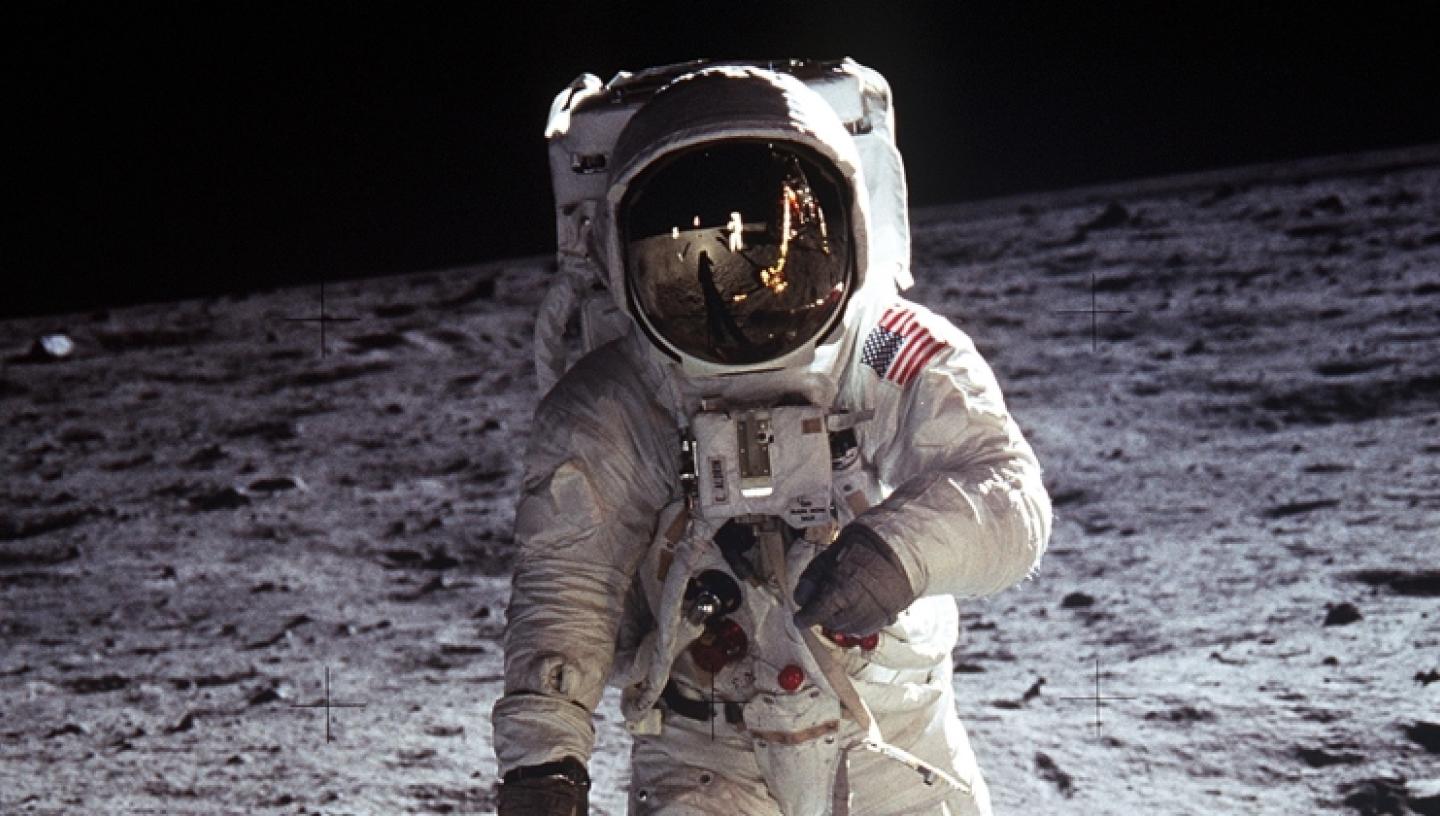
Space race timeline
What was the Space Race? When did it happen? How did it affect the world?
Explore and learn about the key events and achievements that shaped almost 20 years of competition between the United States and the Soviet Union.
If you want to find out about the 'new space race' between USA, China and Russia, click here .
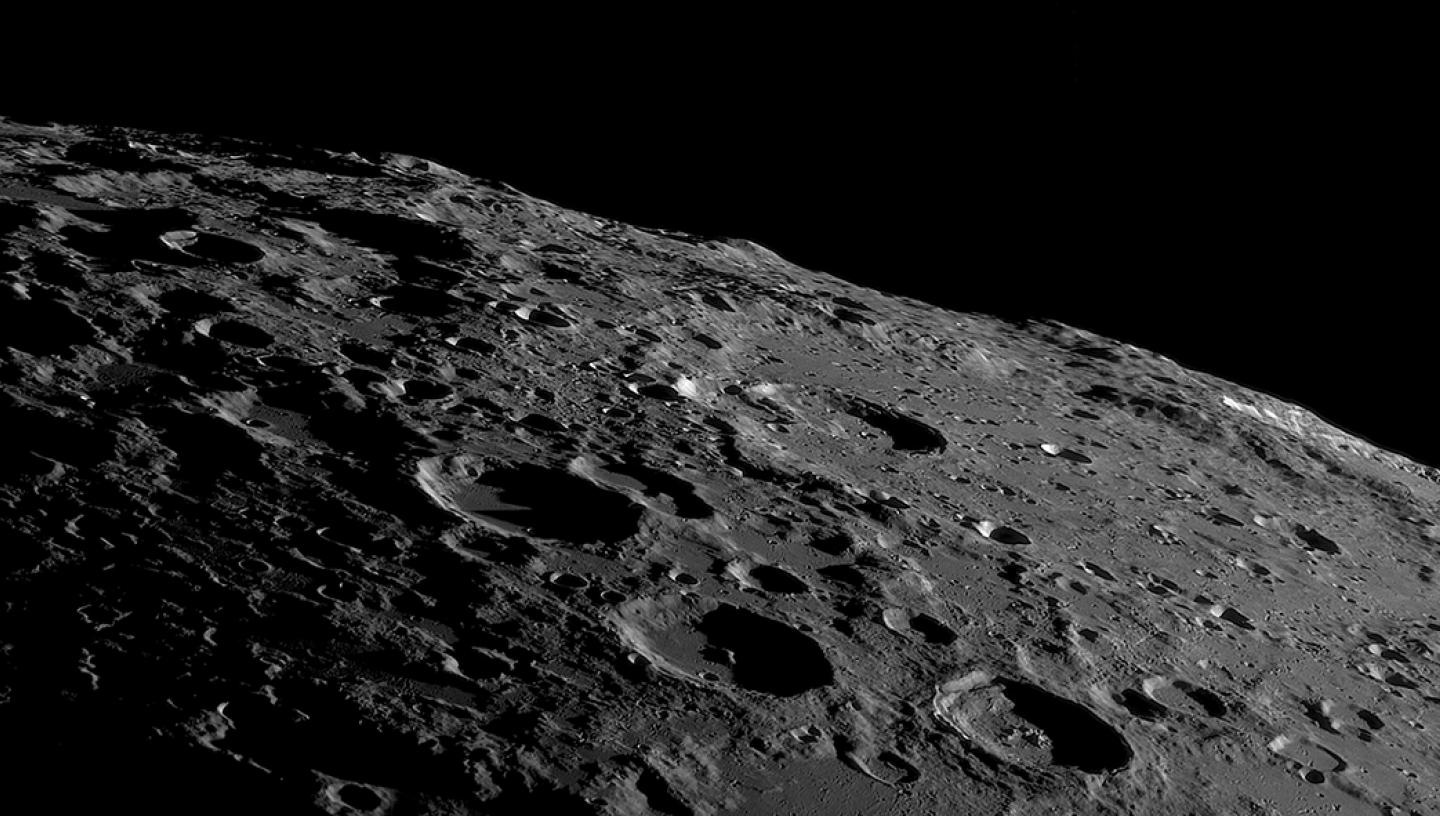
The world's greatest space photography
What was the space race.
The space race was a 20th Century struggle between two nation-states, the Soviet Union (USSR) and the United States (US). The pursuit for both was the domination of space flight technologies. The competition began on 2 August 1955, when the Soviet Union responded to the US announcement of their similar intent to launch artificial satellites.
The space race has its origins in the nuclear arms race between the two nations following the Second World War. Both sides were aided by German missile technology and scientists from their missile programme. The technological advantages required for such power were seen as necessary for national security and political superiority. The space race produced groundbreaking efforts to launch artificial satellites; space probes of the Moon, Venus, and Mars, and human space voyages in low Earth orbit and lunar missions.
The space race between the United States (US) and the Soviet Union (USSR) was a remarkable time in history with many far-reaching achievements in science, space exploration, and technology. This timeline shows the twenty-year competition between the two nations.
2 August 1955: The USSR responds to the US announcement that they intend to launch the first artificial satellite into space with a satellite of their own.
4 October 1957: The USSR successfully launches Sputnik 1, the first Earth-orbiting satellite in history.
3 November 1957: The USSR successfully launches Sputnik 2, carrying a dog named Laika into space. They become the first nation to successfully send a living organism into orbit.
31 January 1958: The US enter the space race by launching Explorer 1, the first US satellite to reach orbit. It carried experimental equipment that led to the discovery of the Van Allen radiation belt.
1 October 1958: The National Aeronautics and Space Administration (NASA) is created in the US, replacing the National Advisory Committee on Aeronautics (NACA).
18 December 1958: The US launch SCORE, the world's first communications satellite. It captured world attention by broadcasting a pre-recorded Christmas message from US President Dwight D. Eisenhower, becoming the first broadcast of a human voice from space.
2 January 1959: The USSR launches Luna 1, known as the first "cosmic rocket" as it accidentally escaped the orbit of the Moon due to the object having too much speed. Luna 1 becomes the first human-made object to leave the orbit of the Earth and orbit the sun instead.
2 August 1959: The US launches Explorer 6, the world's first weather satellite and obtains the first pictures of Earth from space.
12 September 1959: The USSR launches Luna 2 and accomplishes its mission of creating the first spacecraft to reach the surface of the Moon.
4 October 1959: The USSR launches Luna 3 and succeeds in their mission of sending an object into orbit around the Moon and photographing the far side of the Moon.
19 August 1960: Aboard the Soviet Union's Sputnik 5, the first animals (two dogs, Belka and Strelka) and a range of plants are returned alive from space.
31 January 1961: Ham, a US chimpanzee, becomes the first hominid (or great ape) in space and the first to successfully survive the landing.
12 April 1961: The Soviet Union achieve a clear triumph in the space race. Aboard the Vostok 1, Yuri Gagarin makes a single orbit around the Earth and becomes the first man to reach space. He remained in space for one hour and forty-eight minutes before landing in Saratov Oblast, west Russia.
5 May 1961: The US achieve the first pilot-controlled journey and first American in space with Alan Shepard aboard the Mercury-Redstone 3 (or Freedom 7) spacecraft. On this flight, Shepard did not orbit Earth. He flew 116 miles high. The flight lasted about 15 minutes.
16 June 1963: Valentina Tereshkova becomes the first civilian and first woman in space. She spends almost three days in space, orbiting the Earth 48 times aboard her spacecraft, Vostok 6.
18 March 1965: Alexei Leonov leaves his spacecraft, the Voskhod 2, in a specialized spacesuit and conducts a twelve-minute spacewalk, the first of its kind.
14 July 1965: The US satellite, Mariner 4, performs the first successful voyage to the planet Mars, returning the first close-up images of the Martian surface.
1967: This year proves the most deadly of the space race for both the US and Soviet Union. In January, American astronauts Ed White, Gus Grissom, and Roger Chaffee die when a fire ignited in their Apollo 1 capsule on the launch pad. Only a few months later the Soviet cosmonaut Vladimir Komarov is also killed when the parachute on his Soyuz 1 capsule fails to open on his reentry into Earth's atmosphere.
21 December 1968: US spacecraft Apollo 8 becomes the first human-crewed spacecraft to reach the Moon, orbit it, and successfully return to Earth.
20 July 1969: Neil Armstrong and later Edwin "Buzz" Aldrin become the first men to walk on the Moon while their crewmate Michael Collins continues to orbit the Moon aboard the Apollo 11. This secured a victory for America in the space race with a televised landing witnessed around the world by 723 million people.
Find out more about Apollo 11
11 April 1970: The US Apollo 13 mission is known as the first explosion onboard a spacecraft where the crew survived.
19 April 1971: The USSR launches the first space station. Parts of this spacecraft will become core segments of the International Space Station (ISS) almost thirty years later in November 2000.
1 August 1971: David Scott, commander of the Apollo 15 mission, becomes the first person to drive on the Moon. He's also remembered for paying tribute to the Soviet Union and US astronauts who died in the advancement of space exploration. When walking on the Moon, Scott places a plaque with a list of the dead. Alongside this, he leaves a small aluminium sculpture of an astronaut in a spacesuit, created by Belgian artist Paul Van Hoeydonck.
15 July 1975: With tensions between the US and USSR softening, the first cooperative Apollo-Soyuz mission is launched. With two separate flights, the Apollo and Soyuz spacecraft dock in space and the two commanders Tom Stafford and Alexei Leonov exchange the first international handshake. This act can be seen to symbolically end the space race, paving the way for future joint missions, such as the International Space Station and the Shuttle-Mir programme.
Never miss a shooting star
Sign up to our space newsletter for exclusive astronomy highlights, night sky guides and out-of-this-world events.
Space race facts
The first animals sent into space were fruit flies .
These were carried aboard a Second World War V2 rocket on 20 February 1947. Find out more about the first animals in space
Dogs were sent into space
While the US often sent primates on test flights, the Soviet Union preferred to use dogs. They were seen to be more obedient, and Moscow stray dogs were reckoned to be more equipped to deal with the extreme conditions and potential hunger of space travel.
There is a solar powered satellite
The US Navy's Vanguard 1 was the first solar-powered satellite. Launched on 17 March 1958, it remains the oldest human-made probe in orbit. Although communication with the satellite is now lost, it will stay in space for many years to come.
Yuri Gargarin started a tradition
On the 12 April 1961, the first man in space, Yuri Gagarin asked the bus driver to stop on the route to the launchpad and urinated against the right-hand back tyre of the bus. This act has become a tradition for all astronauts travelling into space. Female astronauts bring vials of their urine to splash on the wheel.
Astronauts were nearly cosmonauts
In the 1950s an ongoing discussion began at NASA between astronauts and cosmonauts. The deputy administrator wanted to name US travellers in space as cosmonauts, the term applied to Russian spacemen. He felt that "cosmos" was more applicable to space travel than just the term used to stars (or "Astro"). However, while he made a clear point, he was outvoted by his peers.
Alan Shepard played golf on the Moon
On 2 February 1971, Alan Shepard became the first human to play golf on the Moon. After smuggling a makeshift golf club aboard his Apollo 14 lunar mission, Shepard hit two balls just before liftoff. Find out about what's been left on the Moon
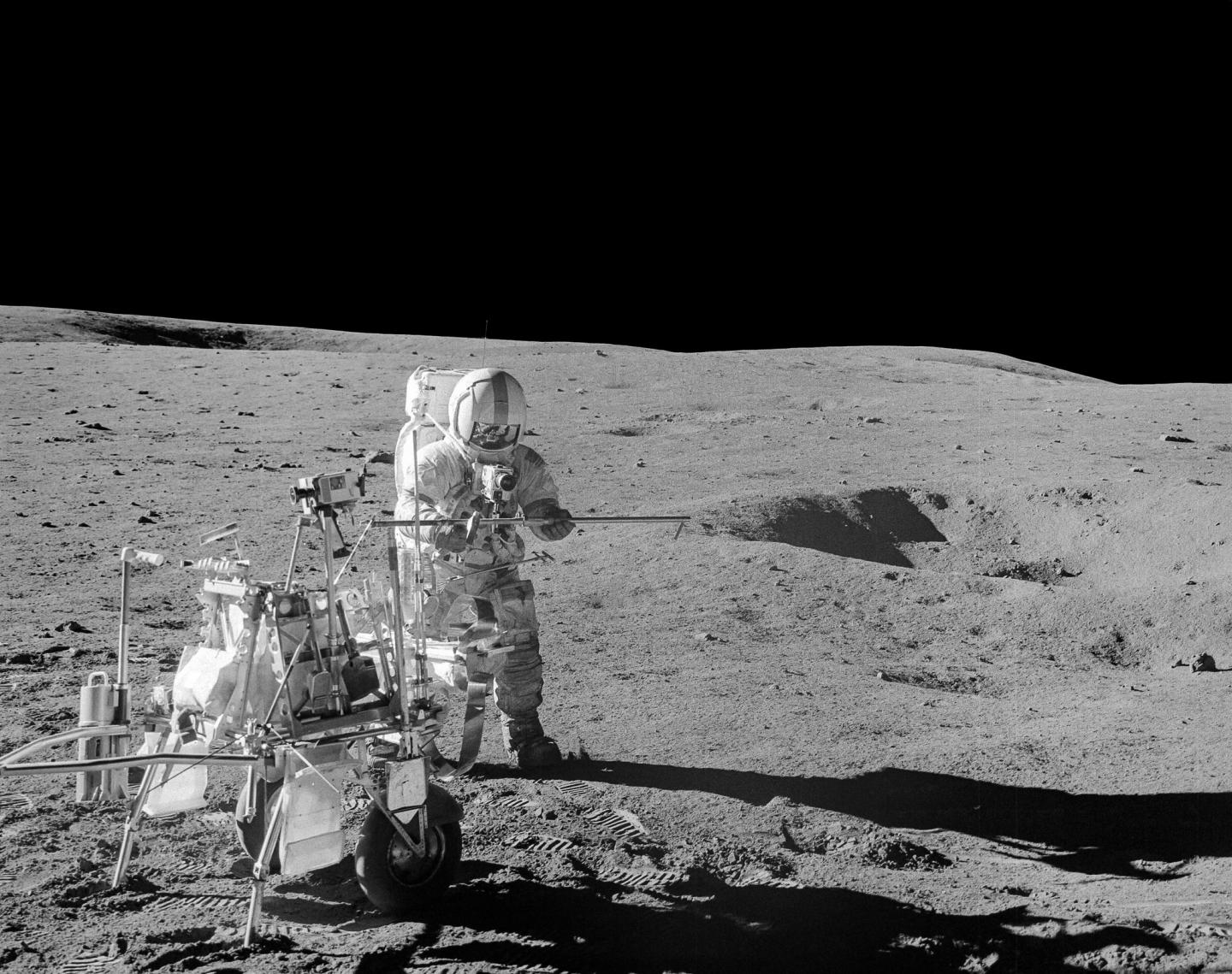
The Mercury Seven were the oldest
The Mercury Seven were the group of seven astronauts that piloted all the crewed spaceflights of the Mercury programme, occurring from May 1961 to May 1963. Of the Mercury Seven, John Glenn went on to become a US senator and on 29 October 1998 (while still a senator), he became the oldest person to fly in space at the age of 77.
Apollo 12 was struck by lightning
On 14 November 1969, Apollo 12 was sent on its lunar mission. The launch was the most distressing of the Apollo programme, as a series of lightning strikes just after liftoff temporarily disabled their power and guidance systems. On stepping onto the lunar surface five days later, Conrad joked, "Man, that may have been a small one for Neil, but that's a long one for me."
The last person to walk on the Moon was Eugene Cernan
Cernan was the Mission Commander of the Apollo 17 mission that occurred between 11 and 14 December 11 1972. Only twelve people (all US astronauts) had done so before, and none have done so since. He walked on the Moon with geologist and astronaut, Harrison Schmitt.
Who won the space race?
With no official measure of success, the winner of the space race is a point of controversy. Most historians agree that the space race ended on 20 July 1969 when Neil Armstrong stepped onto the Moon for the first time. As the climax of space history and exploration, the lunar landing led to a triumph for the US.
While the US set a man on the Moon first, their success was fed by a series of pioneering achievements by the Soviet Union. The Space Race can be seen as a climactic comeback for the United States starting in 1968, rather than a decisive victory.
Following the Moon landing, the Soviet Union concentrated their efforts on building a space station. On 7 June 1971, the Soyuz 11 spacecraft successfully docked with the Salyut 1 space laboratory and completed a record 22-day stay - demonstrating that space exploration would continue.
Furthermore, in May 1972, the US and the Soviet Union negotiated an easing of hostile relations. This "thaw" in the cold war led to cooperation between the two nations on future missions, and the space race became a joint venture.
The space race and the Cold War
Following the Second World War in 1946, tensions rose between two of the victors; the Soviet Union (USSR) and the United States (US) The primary source of conflict arose from the struggle between two political beliefs of communism (USSR) and capitalism (US). This conflict became known as the Cold War.
The term cold in this context meant that there was no direct fighting between the two sides, but each sponsored and supported many conflicts across the world. The Cold War lasted until 1991 with the collapse of the Soviet Union.
The space race played a significant part in the Cold War as the Americans and Soviets competed to prove their technological and intellectual superiority by becoming the first nation to put a human into space. From beginning to end, the world's attention was captivated by this contest for dominance.
How did the space race affect the world?
The space race has had a broader impact on society than just space exploration; here are some of the ways the world has changed.
Communication
The Earth is now surrounded by a network of satellites, which provide broadband communications and high-definition television, data used for weather reporting and GPS navigation and positioning. Many of these tools and systems were created and developed during the space race.
The image processing used in CAT scans and radiography were both initially developed for deep space imaging and photography. NASA's innovations into shock absorbent materials also helped create more functionally dynamic artificial limbs.
The world's first portable computer and mouse were created for space exploration and adapted for the commercial markets. Even the wireless headsets we use today originate from NASA creating hands-free equipment for astronauts and pilots. One of the classic examples is NASA's creation of the ball-point pen for writing in space. However, the Soviet Union found a cost-effective method of using a pencil.
President Kennedy space race speech
On 12 September 1962, President John F. Kennedy delivered a speech to a large crowd gathered at the Rice Stadium in Houston, Texas. The speech called for an ambitious space exploration programme that included not just missions to put astronauts on the Moon, but various other space projects such as communications and weather satellites. The quotation "We choose to go to the Moon" is remembered as the tagline from the speech. The US would succeed in this mission eight years later, but Kennedy would not be around to see it. He was assassinated two years later in Dallas, Texas on 22 November 1963.
What even started the space race?
Following the Second World War, the United States and the Soviet Union competed to see who had the best technology in space. This included events such as the first satellite to orbit Earth, the first human-crewed spacecraft and the first person to walk on the Moon. The space race was considered vital by the two nations as it showed the world which country had the superior scientific, economic and political systems.
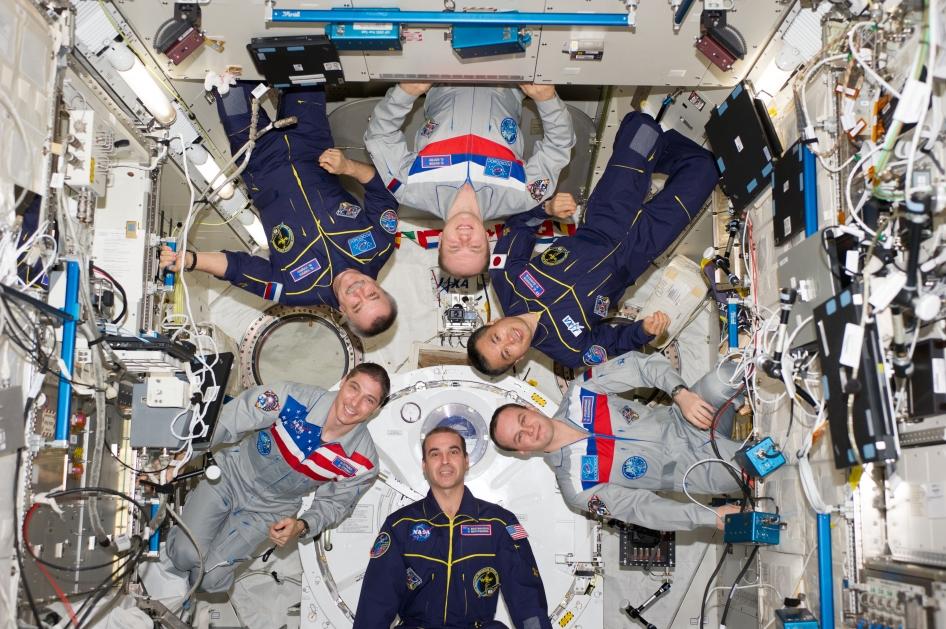

Suggested Searches
- Climate Change
- Expedition 64
- Mars perseverance
- SpaceX Crew-2
- International Space Station
- View All Topics A-Z
Humans in Space
Earth & climate, the solar system, the universe, aeronautics, learning resources, news & events.

Join NASA in Celebrating Earth Day 2024 by Sharing a #GlobalSelfie


NASA Selects New Aircraft-Driven Studies of Earth and Climate Change

The Ocean Touches Everything: Celebrate Earth Day with NASA
- Search All NASA Missions
- A to Z List of Missions
- Upcoming Launches and Landings
- Spaceships and Rockets
- Communicating with Missions
- James Webb Space Telescope
- Hubble Space Telescope
- Why Go to Space
- Astronauts Home
- Commercial Space
- Destinations
- Living in Space
- Explore Earth Science
- Earth, Our Planet
- Earth Science in Action
- Earth Multimedia
- Earth Science Researchers
- Pluto & Dwarf Planets
- Asteroids, Comets & Meteors
- The Kuiper Belt
- The Oort Cloud
- Skywatching
- The Search for Life in the Universe
- Black Holes
- The Big Bang
- Dark Energy & Dark Matter
- Earth Science
- Planetary Science
- Astrophysics & Space Science
- The Sun & Heliophysics
- Biological & Physical Sciences
- Lunar Science
- Citizen Science
- Astromaterials
- Aeronautics Research
- Human Space Travel Research
- Science in the Air
- NASA Aircraft
- Flight Innovation
- Supersonic Flight
- Air Traffic Solutions
- Green Aviation Tech
- Drones & You
- Technology Transfer & Spinoffs
- Space Travel Technology
- Technology Living in Space
- Manufacturing and Materials
- Science Instruments
- For Kids and Students
- For Educators
- For Colleges and Universities
- For Professionals
- Science for Everyone
- Requests for Exhibits, Artifacts, or Speakers
- STEM Engagement at NASA
- NASA's Impacts
- Centers and Facilities
- Directorates
- Organizations
- People of NASA
- Internships
- Our History
- Doing Business with NASA
- Get Involved
- Aeronáutica
- Ciencias Terrestres
- Sistema Solar
- All NASA News
- Video Series on NASA+
- Newsletters
- Social Media
- Media Resources
- Upcoming Launches & Landings
- Virtual Events
- Sounds and Ringtones
- Interactives
- STEM Multimedia

Work Underway on Large Cargo Landers for NASA’s Artemis Moon Missions

Mars Science Laboratory: Curiosity Rover

NASA Open Science Initiative Expands OpenET Across Amazon Basin

NASA Motion Sickness Study Volunteers Needed!

Students Celebrate Rockets, Environment at NASA’s Kennedy Space Center

AI for Earth: How NASA’s Artificial Intelligence and Open Science Efforts Combat Climate Change

Sols 4159-4160: A Fully Loaded First Sol

NASA’s Juno Gives Aerial Views of Mountain, Lava Lake on Io

Hubble Captures a Bright Galactic and Stellar Duo

NASA’s TESS Returns to Science Operations

Astronauts To Patch Up NASA’s NICER Telescope

Hubble Goes Hunting for Small Main Belt Asteroids

NASA’s Near Space Network Enables PACE Climate Mission to ‘Phone Home’

NASA Photographer Honored for Thrilling Inverted In-Flight Image

NASA Langley Team to Study Weather During Eclipse Using Uncrewed Vehicles

ARMD Solicitations

Amendment 10: B.9 Heliophysics Low-Cost Access to Space Final Text and Proposal Due Date.

Tech Today: Taking Earth’s Pulse with NASA Satellites
Earth Day 2024: Posters and Virtual Backgrounds

NASA Names Finalists of the Power to Explore Challenge

Diez maneras en que los estudiantes pueden prepararse para ser astronautas

Astronauta de la NASA Marcos Berríos

Resultados científicos revolucionarios en la estación espacial de 2023
60 years ago, the space age began, johnson space center.
On October 4, 1957, the Soviet Union opened the Space Age with the launch of Sputnik, the world’s first artificial satellite. Launched as part of the International Geophysical Year, Sputnik weighed 84 kilograms and orbited the Earth every 90 minutes, sending out a signal that could be heard by amateur radio operators around the world. Sputnik’s launch caught the United States by surprise and led to the creation of NASA. The Space Race was inaugurated between the two countries, as each superpower sought to achieve superiority in space. The competition led to rapid development of space capabilities by both countries, first putting animals and then humans in space and sending automatic probes to the Moon and planets.
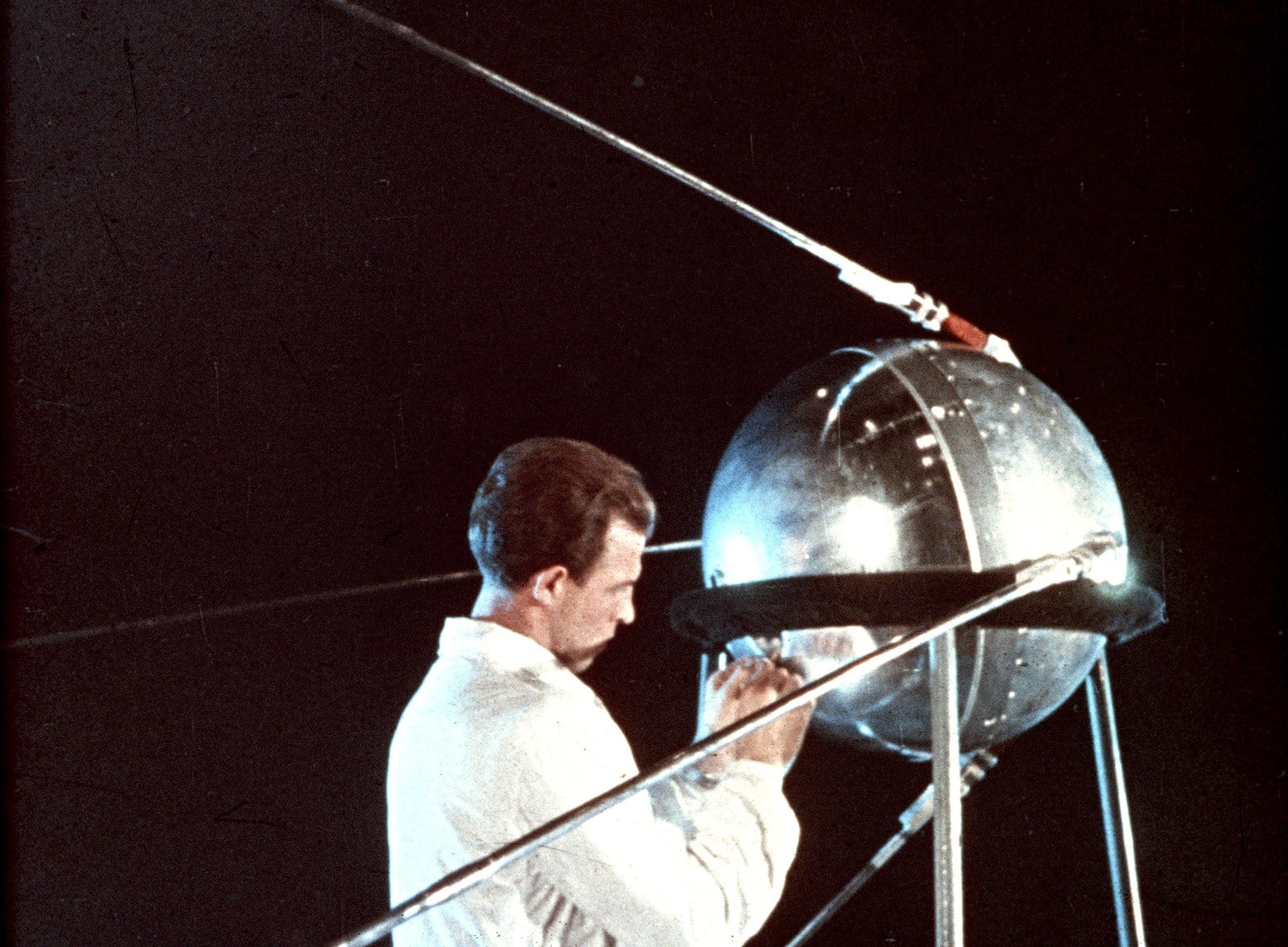
Remarkably, less than 12 years after Sputnik, humans walked on the Moon. Looking back over the past 60 years, developments in space exploration have been staggering, leading to advances in technology, medicine and other areas. Advances in the next 60 years are limited only by our imagination.
History of Space Travel
Learn about the history of humans traveling into space.
The first earthling to orbit our planet was just two years old, plucked from the streets of Moscow barely more than a week before her historic launch. Her name was Laika. She was a terrier mutt and by all accounts a good dog. Her 1957 flight paved the way for space exploration back when scientists didn’t know if spaceflight was lethal for living things.
Humans are explorers. Since before the dawn of civilization, we’ve been lured over the horizon to find food or more space, to make a profit, or just to see what’s beyond those trees or mountains or oceans. Our ability to explore reached new heights—literally—in the last hundred years. Airplanes shortened distances, simplified travel, and showed us Earth from a new perspective. By the middle of the last century, we aimed even higher.
Our first steps into space began as a race between the United States and the former Soviet Union, rivals in a global struggle for power. Laika was followed into orbit four years later by the first human, Soviet Cosmonaut Yuri A. Gagarin. With Earth orbit achieved, we turned our sights on the moon. The United States landed two astronauts on its stark surface in 1969, and five more manned missions followed. The U.S.’s National Aeronautics and Space Administration (NASA) launched probes to study the solar system. Manned space stations began glittering in the sky. NASA developed reusable spacecraft—space shuttle orbiters—to ferry astronauts and satellites to orbit. Space-travel technology had advanced light-years in just three decades. Gagarin had to parachute from his spaceship after reentry from orbit. The space shuttle leaves orbit at 16,465 miles an hour (26,498 kilometers an hour) and glides to a stop on a runway without using an engine.
Space travel is nothing like in the movies. Getting from A to B requires complex calculations involving inertia and gravity—literally, rocket science—to "slingshot" from planet to planet (or moon) across the solar system. The Voyager mission of the 1970s took advantage of a rare alignment of Jupiter, Saturn, Uranus, and Neptune to shave off nearly 20 years of travel time. Space is also dangerous. More than 20 astronauts have died doing their job.
That hasn’t stopped people from signing up and blasting off. NASA’s shuttle program has ended, but private companies are readying their own space programs. A company called Planetary Resources plans to send robot astronauts to the Asteroid Belt to mine for precious metals. Another company named SpaceX is hoping to land civilian astronauts on Mars—the next human step into the solar system—in 20 years. NASA and other civilian companies are planning their own Mars missions. Maybe you’ll be a member of one? Don’t forget to bring your dog.
Space videos
Outer this world, planet earth, calling all earthlings, the milky way, shoot for the stars, what is hubble, how hubble works, read this next, total solar eclipse.
- African American Heroes
Katherine Johnson
- Action and Adventure
Space Explorer
- Terms of Use
- Privacy Policy
- Your California Privacy Rights
- Children's Online Privacy Policy
- Interest-Based Ads
- About Nielsen Measurement
- Do Not Sell My Info
- National Geographic
- National Geographic Education
- Shop Nat Geo
- Customer Service
- Manage Your Subscription
Copyright © 1996-2015 National Geographic Society Copyright © 2015-2024 National Geographic Partners, LLC. All rights reserved
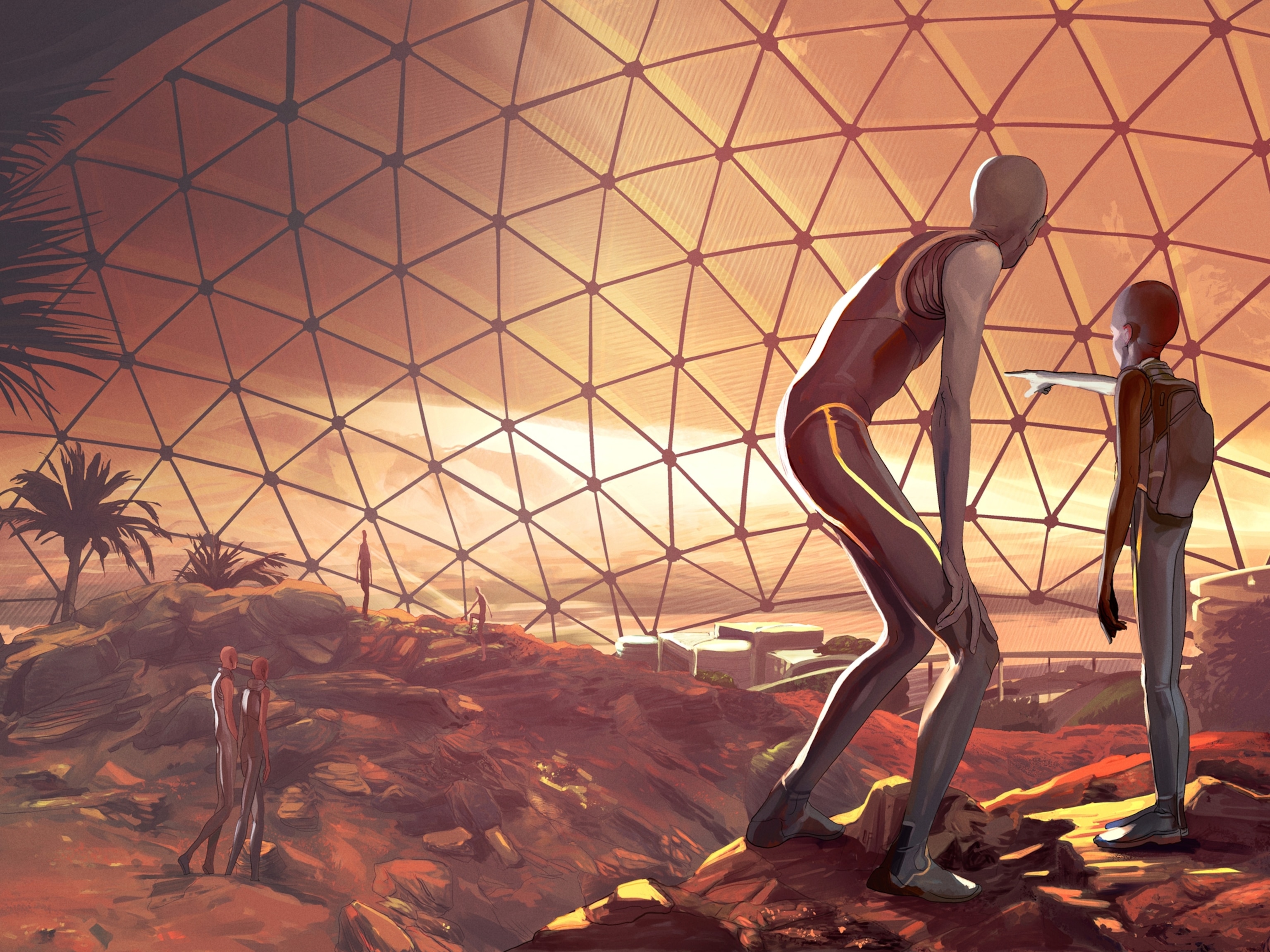
The future of spaceflight—from orbital vacations to humans on Mars
NASA aims to travel to the moon again—and beyond. Here’s a look at the 21st-century race to send humans into space.
Welcome to the 21st-century space race, one that could potentially lead to 10-minute space vacations, orbiting space hotels , and humans on Mars. Now, instead of warring superpowers battling for dominance in orbit, private companies are competing to make space travel easier and more affordable. This year, SpaceX achieved a major milestone— launching humans to the International Space Station (ISS) from the United States —but additional goalposts are on the star-studded horizon.
Private spaceflight
Private spaceflight is not a new concept . In the United States, commercial companies played a role in the aerospace industry right from the start: Since the 1960s, NASA has relied on private contractors to build spacecraft for every major human spaceflight program, starting with Project Mercury and continuing until the present.
Today, NASA’s Commercial Crew Program is expanding on the agency’s relationship with private companies. Through it, NASA is relying on SpaceX and Boeing to build spacecraft capable of carrying humans into orbit. Once those vehicles are built, both companies retain ownership and control of the craft, and NASA can send astronauts into space for a fraction of the cost of a seat on Russia’s Soyuz spacecraft.
SpaceX, which established a new paradigm by developing reusable rockets , has been running regular cargo resupply missions to the International Space Station since 2012. And in May 2020, the company’s Crew Dragon spacecraft carried NASA astronauts Doug Hurley and Bob Behnken to the ISS , becoming the first crewed mission to launch from the United States in nearly a decade. The mission, called Demo-2, is scheduled to return to Earth in August. Boeing is currently developing its Starliner spacecraft and hopes to begin carrying astronauts to the ISS in 2021.
Other companies, such as Blue Origin and Virgin Galactic , are specializing in sub-orbital space tourism. Test launch video from inside the cabin of Blue Origin’s New Shepard shows off breathtaking views of our planet and a relatively calm journey for its first passenger, a test dummy cleverly dubbed “Mannequin Skywalker.” Virgin Galactic is running test flights on its sub-orbital spaceplane , which will offer paying customers roughly six minutes of weightlessness during its journey through Earth’s atmosphere.
With these and other spacecraft in the pipeline, countless dreams of zero-gravity somersaults could soon become a reality—at least for passengers able to pay the hefty sums for the experience.
Early U.S. Spaceflight
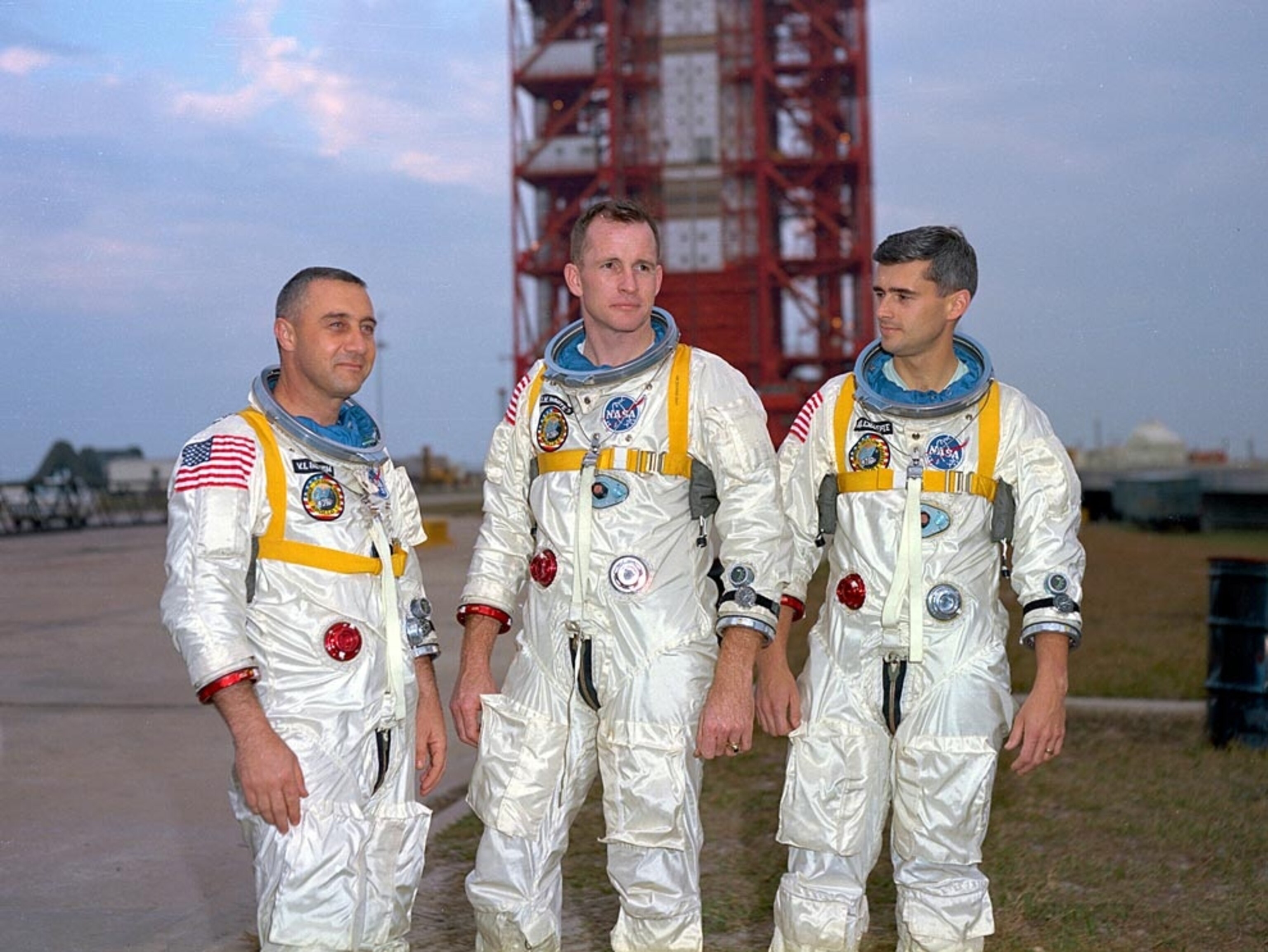
Looking to the moon
Moon missions are essential to the exploration of more distant worlds. After a long hiatus from the lunar neighborhood, NASA is again setting its sights on Earth’s nearest celestial neighbor with an ambitious plan to place a space station in lunar orbit sometime in the next decade. Sooner, though, the agency’s Artemis program , a sister to the Apollo missions of the 1960s and 1970s, is aiming to put the first woman (and the next man) on the lunar surface by 2024.
FREE BONUS ISSUE
Extended lunar stays build the experience and expertise needed for the long-term space missions required to visit other planets. As well, the moon may also be used as a forward base of operations from which humans learn how to replenish essential supplies, such as rocket fuel and oxygen, by creating them from local material.
You May Also Like

In a first, NASA Mars lander feels shockwaves from meteor impacts

SpaceX takes 4 passengers to orbit—a glimpse at private spaceflight’s future

Why go back to the moon? NASA’s Artemis program has even bigger ambitions
Such skills are crucial for the future expansion of human presence into deeper space, which demands more independence from Earth-based resources. And although humans have visited the moon before, the cratered sphere still harbors its own scientific mysteries to be explored—including the presence and extent of water ice near the moon's south pole, which is one of the top target destinations for space exploration .
NASA is also enlisting the private sector to help it reach the moon. It has awarded three contracts to private companies working on developing human-rated lunar landers—including both Blue Origin and SpaceX. But the backbone of the Artemis program relies on a brand new, state-of-the-art spacecraft called Orion .
Archival Photos of Spaceflight
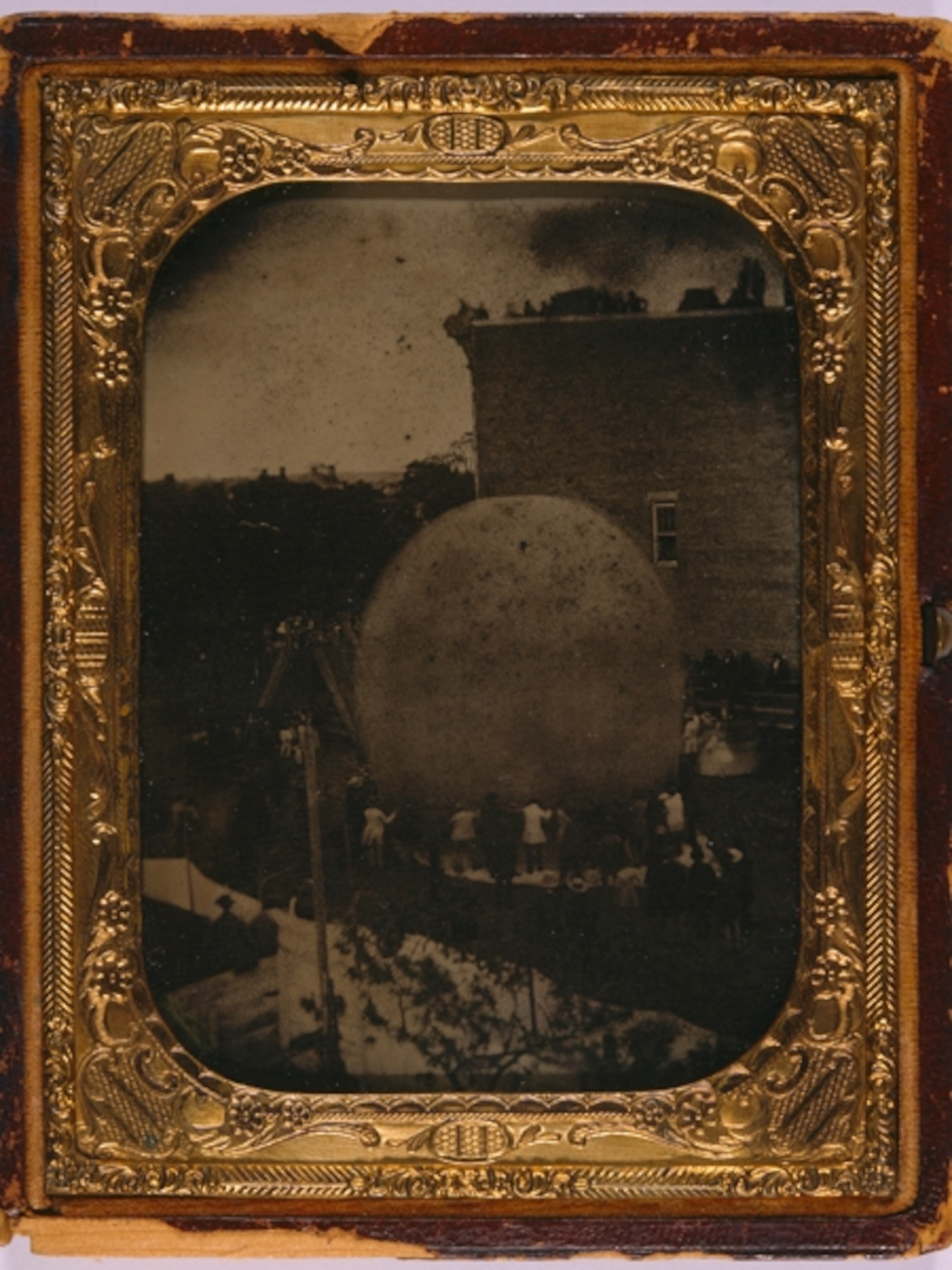
Currently being built and tested, Orion—like Crew Dragon and Starliner—is a space capsule similar to the spacecraft of the Mercury, Gemini, and Apollo programs, as well as Russia’s Soyuz spacecraft. But the Orion capsule is larger and can accommodate a four-person crew. And even though it has a somewhat retro design, the capsule concept is considered to be safer and more reliable than NASA’s space shuttle—a revolutionary vehicle for its time, but one that couldn’t fly beyond Earth’s orbit and suffered catastrophic failures.
Capsules, on the other hand, offer launch-abort capabilities that can protect astronauts in case of a rocket malfunction. And, their weight and design mean they can also travel beyond Earth’s immediate neighborhood, potentially ferrying humans to the moon, Mars, and beyond.
A new era in spaceflight
By moving into orbit with its Commercial Crew Program and partnering with private companies to reach the lunar surface, NASA hopes to change the economics of spaceflight by increasing competition and driving down costs. If space travel truly does become cheaper and more accessible, it’s possible that private citizens will routinely visit space and gaze upon our blue, watery home world—either from space capsules, space stations, or even space hotels like the inflatable habitats Bigelow Aerospace intends to build .
The United States isn’t the only country with its eyes on the sky. Russia regularly launches humans to the International Space Station aboard its Soyuz spacecraft. China is planning a large, multi-module space station capable of housing three taikonauts, and has already launched two orbiting test vehicles—Tiangong-1 and Tiangong-2, both of which safely burned up in the Earth’s atmosphere after several years in space.
Now, more than a dozen countries have the ability to launch rockets into Earth orbit. A half-dozen space agencies have designed spacecraft that shed the shackles of Earth’s gravity and traveled to the moon or Mars. And if all goes well, the United Arab Emirates will join that list in the summer of 2020 when its Hope spacecraft heads to the red planet . While there are no plans yet to send humans to Mars, these missions—and the discoveries that will come out of them—may help pave the way.
Related Topics
- SPACE EXPLORATION
- SCIENCE AND TECHNOLOGY

Second SpaceX megarocket launch ends with another explosion. What happens next?

Why did India land near the moon’s south pole?

U.S. returns to the moon as NASA's Odysseus successfully touches down

In the Arizona desert, NASA prepares for walking on the moon

The moon’s darkest corners are a mystery. This image offers a stunning new glimpse.
- Environment
- Perpetual Planet
- History & Culture
- Paid Content
History & Culture
- Mind, Body, Wonder
- Terms of Use
- Privacy Policy
- Your US State Privacy Rights
- Children's Online Privacy Policy
- Interest-Based Ads
- About Nielsen Measurement
- Do Not Sell or Share My Personal Information
- Nat Geo Home
- Attend a Live Event
- Book a Trip
- Inspire Your Kids
- Shop Nat Geo
- Visit the D.C. Museum
- Learn About Our Impact
- Support Our Mission
- Advertise With Us
- Customer Service
- Renew Subscription
- Manage Your Subscription
- Work at Nat Geo
- Sign Up for Our Newsletters
- Contribute to Protect the Planet
Copyright © 1996-2015 National Geographic Society Copyright © 2015-2024 National Geographic Partners, LLC. All rights reserved
Chronology of U.S. Astronaut Missions (1961 - 1972)
Mission timeline, other missions, search for mission information.
To search for information on any mission, enter the spacecraft name in the box below.
NASA Official: Dave Williams, [email protected] Last Updated: 12 April 2016, DRW

- The Contents
- The Making of
- Where Are They Now
- Frequently Asked Questions
- Q & A with Ed Stone
golden record
Where are they now.
- frequently asked questions
- Q&A with Ed Stone
The Best Children's Site for all things Astronomy, Space and its Exploration!
Space Exploration Timeline & Future Missions For Kids!
History of the space age.
Born from World War II technology, rockets have enabled mankind to put satellites in orbit, send probes to the furthest regions of the solar system and even put men on the Moon! Learn about when, and where, these all happen by reading this timeline of the coolest major milestones and dates of first accomplishments during humanity’s exploration of outer space! Enjoy!
Space Exploration In The 1940’s!
- June 20 th 1944 – A V-2 Rocket launched by Nazi Germany during World War II is the first man-made object to go beyond 100 km – the Kármán line – and reach space!
- October 24 th 1946 – A captured V-2 rocket in US is launched to 105 km (65 miles) and records the first pictures from space.
- February 20 th 1947 – The first animal (fruit flies) reaches space aboard an American V-2.
Space Exploration In The 1950’s!
- July 22 nd 1951 – A Soviet R-1 rocket launches the first dogs (Dezik & Tsygan) into space!
- October 4 th 1957 – The Soviet Union launches the first satellite into orbit called Sputnik-1 which transmits for 22 days! The Space Race begins!
- November 3 rd 1957 – A Soviet rocket launches the first dog (Laika) into orbit!
- January 31 st 1958 - The America’s launch their first satellite called Explorer-1 into orbit.
- January 4 th 1959 – The USSR launches Luna-1 and is the first satellite to reach the vicinity of the Moon and first to enter heliocentric orbit.
- September 13 th 1959 – The USSR launches Luna-2 and is the first probe to touch another world when it impacts with the Moon.
- October 4 th 1959 – The USSR launches Luna-3 the first probe to image the far side of the Moon .
Space Exploration In The 1960’s!
- January 31 st 1961 – The US launches the first Chimpanzee into space who performs tasks and survives.
- April 12 th 1961 – The USSR launches the first human into space - Yuri Gagarin .
- May 5 th 1961 – The US launches the first American into space – Alan Shepard .
- February 20 th 1962 – The US launches their first man into orbit – John Glenn .
- December 14 th 1962 – The first successful planetary flyby ( Venus ) – by Mariner 2 .
- June 16 th 1963 – The USSR puts the first women ( Valentina Tereshkova ) into Space!
- March 18 th 1965 – Cosmonaut Alexei Leonov performs the first spacewalk (extra-vehicular activity) .
- July 14 th 1965 – The first flyby of Mars and first close-up photographs from another planet - Mars .
- February 3 rd 1966 – First soft landing on another world ( the Moon ) and the first images from the surface.
- March 16 th 1966 – During Project Gemini , Gemini 8 completed the first orbital docking between two spacecraft.
- December 21 st 1968 – Apollo 8 carries 3 astronauts to the Moon , for the first time humans leave low Earth orbit.
- July 20 th 1969 – First human walks on the Moon during Apollo 11 mission !
Space Exploration In The 1970’s
- November 17 th 1970 – The USSR lands Lunokhod 1- the first lunar rover.
- December 15 th 1970 – USSR conducts the first soft landing on another planet with Venera 7 on Venus .
- November 14 th 1971 – Mariner 9 becomes the first probe to orbit another planet.
- March 3 rd 1972 – Pioneer 10 becomes the first probe to reach escape velocity of the Solar System and crosses the asteroid belt enroute to Jupiter .
- February 5 th 1974 – Mariner 10 uses a gravity assist for the first time enroute to flyby Mercury for the first time!
- August 20 th 1977 – Voyager 2 launches on its epic journey through the outer planets.
- September 5 th 1977 – Voyager 1 launches bound for Jupiter , Saturn and Titan !
Space Exploration In The 1980’s
- April 12 th 1981 – Launch of the Space Shuttle Columbia – the first reusable (orbital) spacecraft!
- January 24 th 1986 – First Uranus flyby by Voyager 2 .
- January 28 th 1986 – Challenger disintegration shortly after launch.
- February 19 th 1986 – Mir Space Station becomes the first consistently inhabited space station.
- May 4 th 1989 – The Magellan spacecraft launches from the payload bay of the Space Shuttle bound for Venus to map the surface through the dense clouds.
- August 25 th 1989 – First Neptune flyby by Voyager 2 .
Space Exploration In The 1990’s
- April 24 th 1990 – The famous Hubble Space Telescope is launched into space aboard Shuttle Discovery .
- October 21 st 1991 – The first flyby of an asteroid in the asteroid belt by Galileo.
- March 22 nd 1995 - Record longest duration spaceflight (437.7 days) set by Valeri Polyakov.
- December 7 th 1995 – Galileo achieves the first orbit of Jupiter .
- July 4 th 1997 – Mars Pathfinder becomes the first operational rover on another planet.
- October 24 th 1998 – Deep Space 1 launches to test the ion propulsion system .
- November 20 th 1998 – Construction of the International Space Station (ISS) begins.
Space Exploration In The 2000’s
- February 14 th 2000 – The first spacecraft ( NEAR Shoemaker ) to orbit an asteroid!
- April 28 th 2001 – American Dennis Tito became the first paying space tourist to go to space on a Russian Soyuz spacecraft and spent 8 days at the ISS.
- February 2003 – The Space Shuttle Columbia burns up during re-entry killing 7 astronauts.
- July 1 st 2004 – First spacecraft ( Cassini-Huygens ) to enter orbit around Saturn .
- January 14 th 2005 – The Huygens probe performs the first soft landing beyond Mars on Titan !
- March 6 th 2009 – The Kepler spacecraft is launched to discover Exoplanets in the Milky Way .
Space Exploration In The 2010’s
- March 18 th 2011 – A spacecraft orbits Mercury for the first time – MESSENGER .
- July 21 st 2011 – The final flight of the Space Shuttle Atlantis signals the end of the Shuttle Program.
- May 25 th 2012 – A SpaceX Dragon cargo capsule became the first commercial spacecraft to successfully rendezvous with and attach to the ISS.
- August 25 th 2012 – A man-made probe reaches interstellar space – Voyager 1!
- November 12 th 2014 – The Rosetta spacecraft performs a soft landing on a comet.
- March 6 th 2015 – the Dawn spacecraft enters orbit around dwarf planet Ceres becoming the first spacecraft to visit Ceres and to orbit two bodies.
- July 15 th 2015 – The New Horizons spacecraft makes the first flyby of Pluto and its moons.
- August 10 th 2015 – Lettuce became the first food to be grown and eaten in space.
- December 21 st 2015 – Space Exploration Corp (SPACEX) successfully lands the Falcon 9 first stage. The first time an orbital class rocket has been recovered.
- March 30 th 2016 – SpaceX reuses a previously flown Falcon 9 first-stage, the first orbital-class 1 st stage to be reflown in history.
Missions and Spaceflight Milestones Of The Future!
- 2019/2020 - Virgin Galactic and Blue Origin will start taking paying space tourists into space via sub-orbital flights.
- 2019/2020 – SpaceX and Boeing plan to launch astronauts to the International Space Station aboard their Starliner and Dragon Crew capsules!
- 2021 – NASA plans to launch the James Webb Telescope which will likely create many discoveries.
- 2023 – NASA intends to send astronauts on a lunar flyby mission aboard their new Space Launch System (SLS) rocket. The first time humans have left low Earth orbit since 1972 (the Apollo 17 mission).
- 2024 – SpaceX intends to send their new Starship spacecraft on a trip around the Moon with paying passengers for a journey called Dear Moon !
- 2030 – The European Space Agency (ESA) Jupiter Icy Moons Explorer will enter orbit around Ganymede becoming the first probe to orbit another planets moon.
- 2030s – NASA plans to launch the Orion spacecraft using the Space Launch System (SLS) and send astronauts on a 2 year journey to Mars .
- 2050’s – Could humans send a manned mission to the moons of Saturn ?
- 2100’s – Could human beings build an interstellar spaceship capable of travelling to a nearby star system with Earth-like exoplanets ? Is this our destiny to venture out, explore and live amongst the stars of the Milky Way Galaxy ?
Back To Space Exploration
Cool future missions.

COMMENTS
Timeline of space exploration. This is a timeline of space exploration which includes notable achievements, first accomplishments and milestones in humanity's exploration of outer space . This timeline generally does not distinguish achievements by a specific country or private company, as it considers humanity as a whole.
Learn about the major milestones and events in the history of space travel, from the first animals and humans in space to the first space stations and telescopes. Explore the achievements and challenges of different countries and companies in their quest to explore the unknown of space.
Space exploration - Milestones, Achievements, History: The first artificial Earth satellite, Sputnik 1, was launched by the Soviet Union on October 4, 1957. The first human to go into space, Yuri Gagarin, was launched, again by the Soviet Union, for a one-orbit journey around Earth on April 12, 1961. Within 10 years of that first human flight, American astronauts walked on the surface of the Moon.
In addition to launching the first artificial satellite, the first dog in space, and the first human in space, the Soviet Union achieved other space milestones ahead of the United States. These milestones included Luna 2, which became the first human-made object to hit the Moon in 1959. Soon after that, the U.S.S.R. launched Luna 3.
June 3, 1965: Ed White, during the Gemini 4 mission, becomes the first American to walk in space. July 14, 1965: Mariner 4 executes the first successful Mars flyby. Aug. 21, 1965: Gemini 5 ...
A chronological list of major events and milestones in the history of space exploration, from 1957 to 2011. Learn about the first satellites, spacecraft, probes, missions, and astronauts that shaped the U.S. and Soviet space programs.
Do you want to learn more about the amazing achievements and milestones of NASA in the past six decades? Visit this webpage to explore 60 moments in NASA history that shaped the course of space exploration, science, and technology. From the first human in space to the latest rover on Mars, you will find fascinating stories and images that showcase NASA's legacy and vision.
Project Mercury, the first U.S. program to put humans in space, made 25 flights, six of which carried astronauts between 1961 and 1963. The objectives of the program were: to orbit a human spacecraft around Earth, to investigate a person's ability to function in space, and to recover both the astronaut and spacecraft safely.
Space exploration remains one of the greatest technological advances in human history. Learn about the Apollo missions, the Space Shuttles Columbia and Challenger, Neil Armstrong and more.
Space Exploration Timeline. Get information, facts, photos, news, videos, and more about space exploration and missions from National Geographic. October 14, 2009. From the dawn of man until very ...
1961: A Russian, Major Gherman Titov, becomes the first astronaut to spend a day in space, returning to Earth safely after 25 hours in space. 1962: John Glenn becomes the first American astronaut ...
Boris Volynov; Aleksey Yeliseyev (up); Yevgeny Khrunov (up) Jan. 15-18, 1969. Yeliseyev and Khrunov spacewalked to Soyuz 4. Apollo 9. U.S. James McDivitt; David Scott; Russell Schweickart. March 3-13, 1969. test of Lunar Module in Earth orbit. Apollo 10.
This Space Travel Timeline details the history of space travel and exploration including details of the Space Race between the USA and the USSR. Contents. First Rockets Space Race 1970s 1980s 1990s 2000s 2010s - present. Space Travel Timeline - First Rockets. 1926 (16th March)
space exploration, investigation, by means of crewed and uncrewed spacecraft, of the reaches of the universe beyond Earth 's atmosphere and the use of the information so gained to increase knowledge of the cosmos and benefit humanity. A complete list of all crewed spaceflights, with details on each mission's accomplishments and crew, is ...
Space race timeline. 2 August 1955: The USSR responds to the US announcement that they intend to launch the first artificial satellite into space with a satellite of their own. 4 October 1957: The USSR successfully launches Sputnik 1, the first Earth-orbiting satellite in history. 3 November 1957: The USSR successfully launches Sputnik 2 ...
Looking back over the past 60 years, developments in space exploration have been staggering, leading to advances in technology, medicine and other areas. Advances in the next 60 years are limited only by our imagination. On October 4, 1957, the Soviet Union opened the Space Age with the launch of Sputnik, the world's first artificial satellite.
Learn about the milestones and challenges of human space exploration from Laika to Mars. See photos, videos, and facts about space missions, stations, probes, and more.
This infographic presents a timeline of space-related achievements by the U.S.S.R. and the U.S. between 1957 and 1969. A description of the timeline is below. On October 4, 1957, the U.S.S.R. launched Sputnik 1, the first artificial satellite. On November 3, 1957, the U.S.S.R. placed the first animal in a spacecraft, the dog Laika aboard Sputnik 2.
NASA aims to travel to the moon again—and beyond. Here's a look at the 21st-century race to send humans into space. Private spaceflight is not a new concept. In the United States, commercial ...
Mission Timeline. 1961 Mercury Redstone 3 - 5 May 1961 - Earth Suborbital (Shepard) Mercury Redstone 4 - 21 July 1961 - Earth Suborbital (Grissom) 1962 ... NASA Goddard Space Flight Center Greenbelt, MD 20771 +1-301-286-1258. NASA Official: Dave Williams, [email protected]
The First Human-Made Object in Interstellar Space. Voyager 1 enters interstellar space, passing beyond the heliopause, which is the boundary between our solar bubble and the matter ejected by explosions of other stars. It is the first time a human-made object crosses the threshold of interstellar space.
Timeline. On May 25, 1961, U.S. President John F. Kennedy commits the United States to landing astronauts on the Moon by 1970. ... Facts About the Moon and Space Travel. A total of 12 astronauts walked on the Moon. The Moon has had a total of 24 human visitors. The Moon's average distance to Earth is 238,855 miles.
April 12th 1961 - The USSR launches the first human into space - Yuri Gagarin. May 5th 1961 - The US launches the first American into space - Alan Shepard. February 20th 1962 - The US launches their first man into orbit - John Glenn. December 14th 1962 - The first successful planetary flyby ( Venus) - by Mariner 2.